September 24, 2012
The Wild Birds of Telegraph Hill
.jpg)
Above: Unknown bird Townsend's Warbler (Dendroica townsendi) on Greenwich Steps, Telegraph Hill, San Francisco.
.jpg)
Above: Unknown bird Chestnut-backed Chickadee (Poecile rufescens) on Bottlebrush on Filbert Steps, Telegraph Hill, San Francisco.
.jpg)
Above: Unknown bird Chestnut-backed Chickadee (Poecile rufescens) on Bottlebrush on Filbert Steps, Telegraph Hill, San Francisco.
.jpg )
Above: Pygmy Nuthatch (Sitta pygmaea) on the Greenwich Steps, Telegraph Hill, San Francisco.
http://www.whatbird.com/forum/index.php?/topic/85149-birda-in-san-francisco-last-week/
Posted by Rob Kiser on September 24, 2012 at 9:16 PM : Comments (0) | Permalink
May 4, 2012
Great Horned Owlets
.jpg)
Above: Great Horned owlets (Bubo virginianus) near Morrison, Colorado.
Posted by Rob Kiser on May 4, 2012 at 11:28 PM : Comments (1) | Permalink
January 25, 2012
Critters in the hood
Here's some critters I shot recently around the hood.
.jpg)
Above: Coyote (Canis latrans). Canon EOS 40D with L-Series Canon f/4.0 IS USM 600mm lens. The coyotes are omnivores, and opportunistic scavengers. This one was chasing after a Northern Magpie that was scolding it. Image selection in Cam2PC. Post processing in Adobe Photoshop CS5.
.jpg)
Above: Fox Squirrel (Sciurus niger). Canon EOS 40D with L-Series Canon f/4.5-5.6 IS USM 400mm lens. This squirrel box was a project Jennifer dreamed up in honor of "Squirrel Appreciation Day". The squirrels are said to "hibernate" at this time of year, though their hibernation is mainly a period of less activity, as opposed to sleeping for months at a time. This time of year, they commonly move from their leaf nests into hollow tree cavities, if possible. Image selection in Cam2PC. Post processing in Adobe Photoshop CS5.
.jpg)
Above: Immature Red-tailed Hawk (Buteo jamaicensis). Note that this is an young bird as indicated by the yellow eyes and prominent tail banding. Canon EOS 40D with L-Series Canon f/4.0 IS USM 600mm lens. Image selection in Cam2PC. Post processing in Adobe Photoshop CS5.
Posted by Rob Kiser on January 25, 2012 at 12:49 AM : Comments (0) | Permalink
November 13, 2011
The Butcher Bird
.jpg)
Well, the leaves are off the trees, so the "Butcher Birds" are back. Jen and I spotted this Northern Shrike (Lanius excubitor) this morning near Charlie's house off North Turkey Creek.
This bird catches other birds and eats them. If he can't eat them all in one meal, he pins their carcass on a barbed-wire fence or a thorn bush and returns for them later. Hence the name, "Butcher Bird".
They are migratory and only appear after the leaves are off the trees. Here are my Butcher Bird photos from 2010 and 2009.
Posted by Rob Kiser on November 13, 2011 at 5:16 PM : Comments (0) | Permalink
May 14, 2011
Swainson's Hawk
.jpg)
Above: Swainson's Hawk (Buteo swainsoni). This is the first Swainson's Hawk I've photographed this year. I think that they returned to Colorado about a month later than last year, for whatever reason.
.jpg)
Above: Swainson's Hawk (Buteo swainsoni).
.jpg)
Above: Swainson's Hawk (Buteo swainsoni).
http://www.whatbird.com/forums/forums/233087/ShowThread.aspx#233087
Posted by Rob Kiser on May 14, 2011 at 11:29 PM : Comments (0) | Permalink
February 27, 2011
Red-Tailed Hawks
.jpg)
Above: Immature Red-tailed hawk (Buteo jamaicensis), as indicated by yellow eye color.
.jpg)
Above: Mature Red-tailed hawk (Buteo jamaicensis), as indicated by dark reddish/brown eye color.
Posted by Rob Kiser on February 27, 2011 at 10:40 PM : Comments (0) | Permalink
February 12, 2011
First Day in the Field
.jpg)
So, today was my first day in the field with the new Canon "Cannon", as I like to call it. First of all, I should mention that this camera garners a lot of attention. I had people stop their cars and ask me what type of lens I had. The police approached me for taking photos while parked in the middle of the road. Total strangers asked for me to take their pictures. So, obviously, if I'm going to walk around with this thing, I'm going to have to get some business cards printed out just so people will leave me alone. At this point, they don't even ask if I'm a photographer. There's no plausible denial at this point. I think I've lost that battle.
I shot the camera free-hand, and after a day in the field, I can tell you that my arms and wrists are sore. It's one thing to be able to raise the camera up to your eye. Quite another to old it steady above your head while shooting birds all day. This is more challenging than I'd imagined.
These images aren't great, but for my first day out, I'm happy with them. I need to work with a tripod and a remote shutter release, of course. But a lot of these images were shot from further away than I normally shoot. A large part of bird photography is getting lucky and having the bird sit still while you approach him. The closer you get, the better the shot.
Saw several hawks today. Mostly Red-tailed hawks. Some mature, some immature. Also, I shot a female American Kestrel. We saw a mature Bald Eagle, but it flew before I could get any shots.
.jpg)
.jpg)
.jpg)
Above: Female American Kestrel, as indicated by the lack of blue on the leading edge of wings and the lack of pronounced markings on the breast.
.jpg)
.jpg)
I assume that the bird above is an immature Red-tailed Hawk. (Verifying at Whatbird.com).
Posted by Rob Kiser on February 12, 2011 at 10:14 PM : Comments (1) | Permalink
February 7, 2011
The Butcher Bird
.jpg)
Jennifer and I were driving up the canyon yesterday when I saw a small bird fly across the road. I wasn't clear what it was, but I stopped to get a shot because it looked unusual enough that it caught my attention.
.jpg)
As it turns out, it was a Northern Shrike (Lanius excubitor) eating a male House Finch (Carpodacus mexicanus) with an unusual orange coloration.
This is the 2nd time I've seen a Northern Shrike eating a male House Finch in the winter. (Here's one I shot in December of 2009.)
Posted by Rob Kiser on February 7, 2011 at 6:45 PM : Comments (0) | Permalink
January 21, 2011
Postcards From Nowhere
.jpg)
Above and below: Mature Red-Tailed Hawk (Buteo jamaicensis) in Coraopolis, PA.
.jpg)
Some of the towns I've been in so far this year.
Madison, MS
Dallas, TX
Denver, CO
Milwaukee, WI
Madison, WI
Pittsburgh, PA
Charlotte, NC
Phoenix, AZ
Posted by Rob Kiser on January 21, 2011 at 10:14 AM : Comments (0) | Permalink
January 8, 2011
American Kestrel
.jpg)
Above: Male American Kestrel. This American Kestrel is easily identified as a male by the blue leading edge on the wings and the very pronounced black spots on the chest.
Posted by Rob Kiser on January 8, 2011 at 10:50 PM : Comments (0) | Permalink
January 7, 2011
Immature Red-Tailed Hawk
.jpg)
This is an immature Red-Tailed Hawk. Patagial markings (leading edge of the underside of the wings) make the identification as a Red-Tailed Hawk unmistakable. The yellow eye and tail banding indicate it's an immature hawk.
.jpg)
.jpg)
.jpg)
Posted by Rob Kiser on January 7, 2011 at 5:23 PM : Comments (0) | Permalink
January 5, 2011
Pennsylvania in January
.jpg)
.jpg)
Above: I'm thinking it's an immature bird due to the red eye. I'm thinking Sharp-shinned or Cooper's hawk mainly due to the coloration and distinct broad banding on the tail.
Update: I had the eye color backwards. The red eye indicates a mature bird. Immature would have a yellow eye.
.jpg)
Lack of distinct patagial marks appears to indicate it's not a Red-Tailed Hawk. The elongated tail appears to indicate it's an accipiter.
.jpg)
Posted by Rob Kiser on January 5, 2011 at 9:27 PM : Comments (2) | Permalink
November 11, 2010
Cold Busted
So, I pulled the memory card from the game cam today and it looks like there's a lot more critters out there than I'd realized. Aside from catching myself and Timmy, we've now photographed a fox the size of a pony, a raccoon the size of a bloodhound, two other cats, and a magpie.
Posted by Rob Kiser on November 11, 2010 at 4:35 PM : Comments (2) | Permalink
September 26, 2010
Badger - Three Weeks Old
.jpg)
At this point, Badger is able to fly somewhat. He can get off the ground, and his wing feathers are much more pronounced, but I think he won't be ready to release for another couple of weeks, I'm guessing.
Posted by Rob Kiser on September 26, 2010 at 12:01 AM : Comments (0) | Permalink
September 18, 2010
Badger - Two Weeks Old
.jpg)
Above: Jennifer's pet quail flew today for the first time. He only got a few inches off the ground, but he did get airborne.
.jpg)
.jpg)
Posted by Rob Kiser on September 18, 2010 at 10:04 PM : Comments (0) | Permalink
September 12, 2010
Kenosha Pass
.jpg)
.jpg)
Above: Blue-winged Teal (Anas discors).
http://www.whatbird.com/forums/forums/179326/ShowThread.aspx#179326
.jpg)
.jpg)
Above: Red-breasted Nuthatch (Sitta canadensis).
http://www.whatbird.com/forums/forums/179326/ShowThread.aspx#179326
.jpg)
.jpg)
.jpg)
Above: Dark morph of a mature Red-tailed Hawk (Buteo jamaicensis).
.jpg)
Posted by Rob Kiser on September 12, 2010 at 11:12 PM : Comments (0) | Permalink
September 3, 2010
A Quail Named 'Badger'
.jpg)
Jennifer ordered a dozen quail eggs in the mail and, unfortunately, one of them hatched. Just what I needed - one more mouth to feed. (Granted, it's a fairly small mouth, but have you seen the prices on corn meal lately?) This is a 1 day old Coturnix quail, aka Pharaoh's quail, aka Japanese quail. Scientific name is (Coturnix japonica).
Update: The quail's name is "Badger".
.jpg)
.jpg)
Posted by Rob Kiser on September 3, 2010 at 8:44 PM : Comments (0) | Permalink
Sandhill Crane
.jpg)
Above: Sandhill Crane (Grus canadensis) near Sun Prairie, Wisconsin.
Posted by Rob Kiser on September 3, 2010 at 2:26 PM : Comments (2) | Permalink
August 14, 2010
Lesser Goldfinch
.jpg)
Above: Female Lesser Goldfinch (Carduelis psaltria).
Today, while the girls were engaged in a futile but desperate attempt to dam up North Turkey Creek with rocks, I wandered around and shot these photos of a flock of Lesser Goldfinch (Carduelis psaltria). These shots are not very good, of course, but the bird is very small and equally shy and this today was the first time I'd ever seen it.
.jpg)
Above: Male Lesser Goldfinch (Carduelis psaltria).
.jpg)
Above: Male Lesser Goldfinch (Carduelis psaltria).
http://www.whatbird.com/forums/forums/174542/ShowThread.aspx#174542
Posted by Rob Kiser on August 14, 2010 at 11:19 PM : Comments (0) | Permalink
August 9, 2010
August in Colorado
.jpg)
.jpg)
.jpg)
Posted by Rob Kiser on August 9, 2010 at 12:57 AM : Comments (0) | Permalink
August 7, 2010
Camping at West Chicago Creek
.jpg)
We went camping up at West Chicago Creek campground. I've been there before, but Jen never had. It's not far from the house (about 45 mins) and is fairly scenic. We camped out at probably about 10,000 feet above sea level. Jen even managed to catch a brook trout. Plus, of course we drove up to Echo Lake and fed the ducks. Why not, right?
.jpg)
.jpg)
.jpg)
.jpg)
.jpg)
.jpg)
.jpg)
Posted by Rob Kiser on August 7, 2010 at 9:19 PM : Comments (2) | Permalink
Harvest Moon
.jpg)
We started running Bluebird Trail yesterday, and saw that we have four healthy happy Western Bluebird chicks, but then Jen got distracted by the garden and started harvesting squash and radishes.
.jpg)
Posted by Rob Kiser on August 7, 2010 at 9:08 PM : Comments (0) | Permalink
August 5, 2010
Feeding Ducks
.jpg)
Jen and I went back to the lake today but first, we went to the grocery store and I sent her in to beg for day-old-bread for the ducks. They loaded her up and we paddled the canoe out into the lake. This time, we were surrounded by ducks and geese. At one point, I counted 31 ducks/geese around the canoe. And then, a Mallard hen showed up with 9 baby ducks following her. Very cute. I'll post photos later.
Update: Photos added.
.jpg)
.jpg)
.jpg)
Posted by Rob Kiser on August 5, 2010 at 11:50 PM : Comments (0) | Permalink
August 1, 2010
Gilpin County in August
.jpg)
Wendy and I went for a little ride today through Gilpin County (named after the 1st Governor of the Colorado Territory - William Gilpin). We went up Golden Gate Canyon nearly to the Moffat Tunnel, then back through Coal Creek Canyon. It was mostly rainy, but we managed to snap a few shots along the way.
.jpg)
.jpg)
.jpg)
.jpg)
.jpg)
.jpg)
.jpg)
.jpg)
.jpg)
.jpg)
.jpg)
.jpg)
Posted by Rob Kiser on August 1, 2010 at 11:56 PM : Comments (0) | Permalink
Saturday at the Lake
.jpg)
Jen and I went to the lake on Saturday and paddled around a little bit. We didn't catch anything, but it wasn't like it mattered. We fed the ducks and watched the cormorants, tree swallows, and muskrats.
.jpg)
.jpg)
.jpg)
.jpg)
.jpg)
.jpg)
.jpg)
.jpg)
.jpg)
Posted by Rob Kiser on August 1, 2010 at 11:22 PM : Comments (0) | Permalink
July 29, 2010
Parting Shots from Rocky Mountain National Park
.jpg)
.jpg)
Above: Indian Paintbrush (Castilleja linariaefolia).
.jpg)
.jpg)
Above: Aspen Sunflower (Helianthella quinquenervis).
.jpg)
Above: Mountain Harebell (Campanula lasiocarpa).
.jpg)
Above: Little Pink Elephants (Pedicularis groenlandica).
.jpg)
Above: Tall Chiming Bells (Mertensia ciliate). Family: Borage.
.jpg)
Above: Dwarf Sunflower (Helianthus pumilus).
.jpg)
Above: Colorado Blue Columbine (Aquilegia coerulea)
.jpg)
Above: American Pipit (Anthus rubescens).
.jpg)
.jpg)
.jpg)
.jpg)
.jpg)
.jpg)
.jpg)
Above: Chipping Sparrow (Spizella passerina).
Posted by Rob Kiser on July 29, 2010 at 6:51 PM : Comments (0) | Permalink
July 25, 2010
Rocky Mountain National Park
.jpg)
Above: Bee Balm (Genus: Monarda).
.jpg)
Above: Male Mountain Bluebird in breeding plumage.
.jpg)
Above: Cutleaf Coneflower (Rudbeckia ampla). Aster family.
.jpg)
Above: Golden-mantled Ground Squirrel (Callospermophilus lateralis).
.jpg)
Above: Fireweed (Epilobium angustifolium).
Continue reading "Rocky Mountain National Park"
Posted by Rob Kiser on July 25, 2010 at 11:32 PM : Comments (0) | Permalink
July 21, 2010
Pine Siskin
.jpg)
Above: Male Pine Siskin (Carduelis pinus).
http://www.whatbird.com/forums/forums/170428/ShowThread.aspx#170428
Posted by Rob Kiser on July 21, 2010 at 11:50 PM : Comments (0) | Permalink
July 18, 2010
American Coot
.jpg)
Above: Jen and I saw a few American Coots (Fulica americana) swimming around up on Kenosha Pass yesterday. These birds are not technically ducks, as they don't have webbed feet.
Posted by Rob Kiser on July 18, 2010 at 12:26 AM : Comments (0) | Permalink
July 11, 2010
Red-tailed Hawk?
.jpg)
Above: Saw this bird perched today over Highway 85 near Sedalia, Colorado. I'm thinking it's a Red-tailed Hawk, but not certain. He appears to have a light colored belly with reddish-brown streaking "belly band". Dark eye probably would indicate a mature bird. He never flew, so I'm not clear what the wings look like (shape/markings). The tail does not appear to extend very far past the wings, so I'm thinking Buteo as opposed to Accipiter. The tail looks a little off to me, though. I don't see the prominent sub-terminal black/white band, and it does appear that there is some banding in the tail. Could still be a Red-tail though, I suppose, as they do have more prominent banding when immature. Even mature birds can have a light banding as well. I dunno. Based on the location, I'd say it's more likely to be a Red-tailed or Swainson's, as opposed to a Sharp-shinned/Cooper's/etc.
http://www.whatbird.com/forums/forums/168563/ShowThread.aspx#168563
Update: Confirmed that this is a Red-tailed Hawk (Buteo jamaicensis).
Posted by Rob Kiser on July 11, 2010 at 12:16 AM : Comments (0) | Permalink
July 10, 2010
American Goldfinch
.jpg)
Above: Male American Goldfinch (Spinus tristis) in breeding plumage.
Posted by Rob Kiser on July 10, 2010 at 11:44 PM : Comments (0) | Permalink
Prairie Falcon
.jpg)
Above: Prairie Falcon (Falco mexicanus) near Larkspur, Colorado. Although the Prairie Falcon looks similar to the Peregrine Falcon, the facial "whiskers" on the Prairie Falcon are much more slender facial markings on the Peregrine Falcon. The bird has dark armpits which indicate it is a Prairie Falcon.
http://www.whatbird.com/forums/forums/ShowThread.aspx?PostID=168551#168551
Posted by Rob Kiser on July 10, 2010 at 11:20 PM : Comments (0) | Permalink
Bullock's Oriole
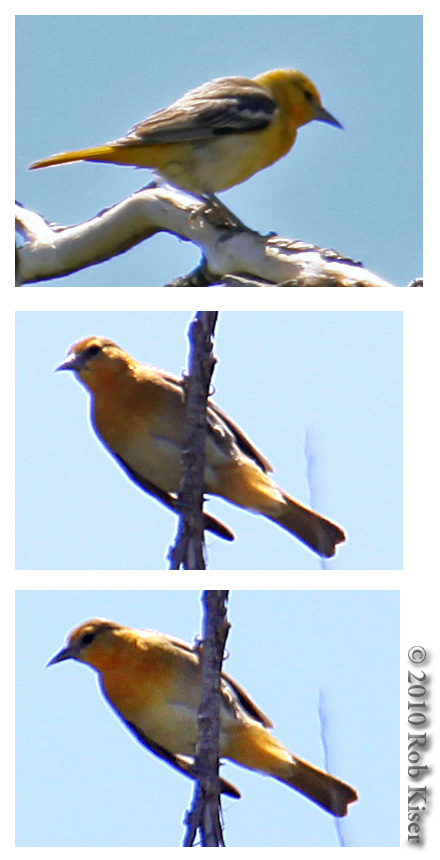
Above: Bullock's Oriole (Icterus bullockii).
http://www.whatbird.com/forums/forums/168420/ShowThread.aspx#168420
Posted by Rob Kiser on July 10, 2010 at 9:24 AM : Comments (0) | Permalink
Black-billed Magpie
.jpg)
Above: Black-billed Magpie (Pica pica).
Posted by Rob Kiser on July 10, 2010 at 12:44 AM : Comments (0) | Permalink
Red-winged Blackbird
.jpg)
Above: Female Red-winged Blackbird (Agelaius phoeniceus).
Posted by Rob Kiser on July 10, 2010 at 12:03 AM : Comments (0) | Permalink
July 9, 2010
Western Meadowlark
.jpg)
Above: Western Meadowlark (Sturnella neglecta).
Posted by Rob Kiser on July 9, 2010 at 11:52 PM : Comments (0) | Permalink
House Finches
.jpg)
Above: Male and Female House Finches (Carpodacus mexicanus).
Posted by Rob Kiser on July 9, 2010 at 11:29 PM : Comments (0) | Permalink
Cordilleran Flycatcher
.jpg)
Above: Cordilleran Flycatcher (Empidonax occidentalis).
Posted by Rob Kiser on July 9, 2010 at 11:09 PM : Comments (0) | Permalink
Northern Flicker
.jpg)
Above: Northern Flicker (Colaptes auratus).
Posted by Rob Kiser on July 9, 2010 at 10:41 PM : Comments (0) | Permalink
Spotted Towhee
.jpg)
Above: Spotted Towhee (Pipilo maculatus).
Posted by Rob Kiser on July 9, 2010 at 10:27 PM : Comments (0) | Permalink
Immature American Robins?
.jpg)
Jen and I saw these two birds today sitting on a barbed wire fence in a field near Morrison, Colorado. There was an American Robin nearby, which made me notice the resemblance (i.e. beak, wings, overall size, etc.) Are these birds possibly immature American Robins?
http://www.whatbird.com/forums/forums/168244/ShowThread.aspx#168244
Update: Confirmed that these are young American Robins. :)
Posted by Rob Kiser on July 9, 2010 at 2:17 AM : Comments (0) | Permalink
Immature House Wren?
.jpg)
Jen and I spied this little critter near Morrison today. I think it might be an immature House Wren (Troglodytes aedon).
.jpg)
http://www.whatbird.com/forums/forums/168237/ShowThread.aspx#168237
We saw this tiny perching brown and white bird this evening near Morrison, Colorado. It has a long, thin, straight bill (presumably for catching insects). The bird appears to be light brown on the back with a white/buff breast. Now that I look at it closer, it appears to have light banding across its tail. Is this possibly an immature House Wren?
Update: This is an immature House Wren (Troglodytes aedon).
Posted by Rob Kiser on July 9, 2010 at 12:12 AM : Comments (0) | Permalink
July 7, 2010
Tree Swallow
.jpg)
Above: Tree Swallow (Tachycineta bicolor).
Posted by Rob Kiser on July 7, 2010 at 2:19 PM : Comments (0) | Permalink
July 6, 2010
Bluebird Trail - 7/6/10
.jpg)
Above: Male Western Bluebird from Box 3.
Box 1: Empty.
Box 2: Empty.
Box 3: Western Bluebird (Sialia mexicana).
Box 4: Abandoned House Wren nest (Troglodytes aedon).
Box 5: Empty.
Box 6: Empty.
Box 562: Empty. The single Mountain Chickadee (Poecile gambeli) chick has fledged. I've recently noticed a Western Bluebird investigating this house. Apparently, this is now prime real estate since the field has been mowed.
Box 7: Five baby Tree Swallows (Tachycineta bicolor).
Box 8: Empty. The six Mountain Bluebird chicks (Sialia mexicana) have fledged.
Posted by Rob Kiser on July 6, 2010 at 11:59 PM : Comments (0) | Permalink
Cordilleran Flycatcher
.jpg)
Above: Cordilleran Flycatcher (Empidonax occidentalis). This shy dimunitive bird prefers pines and coniferous forests. They've apparently built a nest or two out back this summer, as I hear his distinctive call every day. I hunted for them for sometime before I spotted them, as they're so small. When Jennifer finally spotted one, I took her for ice cream. I spotted this one on my own today and got a fairly decent shot of the tiny bird just before it flitted away.
His song sounds like this: Cordilleran Flycatcher song
Posted by Rob Kiser on July 6, 2010 at 11:38 PM : Comments (0) | Permalink
July 3, 2010
Bluebird Trail - 7/3/10
.jpg)
Above: Box 1. I was surprised to find a White-breasted Nuthatch (Sitta carolinensis) squatting in Box 1. I'd seen him hanging around recently, but this bird was just hunkered down in the birdhouse and did not appear to be building a nest. This box previously contained a decoy House Wren (Troglodytes aedon) nest, which I removed.
Not shown: Box 2. This box is currently empty. It previously contained a decoy House Wren (Troglodytes aedon) nest, which I removed.
.jpg)
Above: Box 3. A breeding pair of Western Bluebirds (Sialia mexicana) are currently building a nest in this box. Today I moved this box to a separate post wrapped in tin to prevent predation. The Western Bluebirds were confused at first, but quickly resumed nest building. Previously, this box contained 5 baby Mountain Bluebirds (Sialia currucoides) which were killed by a predator.
Not Shown: Box 4. This box has an empty House Wren (Troglodytes aedon) nest. According to the neighbor's kids, these chicks were killed by our cat Timmy,
Not Shown: Box 5. This box contained a Mountain Chickadee (Poecile gambeli) nest with eggs, but was abandoned, possibly due to predation. Today, I removed the abandoned nest and eggs.
Not Shown: Box 6. This box is empty. It previously contained a House Wren (Troglodytes aedon) nest with 3 eggs, but was abandoned. Possibly due to predation.
.jpg)
Above: Box 562. This box contains one healthy happy Mountain Chickadee chick (Poecile gambeli). The other eggs in the nest did not hatch for whatever reason.
.
.jpg)
Above: Box 7. This box contains 5 healthy Tree Swallow chicks (Tachycineta bicolor).
.jpg)
Above: Box 8. This box contains 6 healthy Western Bluebird chicks (Sialia mexicana).
Posted by Rob Kiser on July 3, 2010 at 10:58 PM : Comments (0) | Permalink
June 30, 2010
Bluebird Trail
.jpg)
Above: Day 17 for six Mountain Bluebird chicks (Sialia mexicana).
Jen and I ran Bluebird Trail for the first time in a long time. The house wren chicks do not look good at all. They all seem to be dead or dying. House 562 has one happy healthy Mountain Chickadee chick. The Tree Swallows have some very tiny chicks that seem to be alive and kicking. The Western Bluebirds are doing great. 6 healthy happy chicks.
Posted by Rob Kiser on June 30, 2010 at 9:36 PM : Comments (0) | Permalink
June 29, 2010
Brown-headed Cowbirds vs. Brewer's Blackbirds
.jpg)
I have no idea what these birds are. I saw them today in Morrison and snapped a few shots. Possibly Brown-headed Cowbirds . Possibly Brewer's Blackbirds Hopefully whatbird.com will clear things up.
http://www.whatbird.com/forums/forums/166371/ShowThread.aspx#166371
Update: They're Brown-headed Cowbirds (Molothrus ater).
Update 2: Or, they're possibly Brewer's Blackbirds (Quiscalus breweri).
Posted by Rob Kiser on June 29, 2010 at 11:09 PM : Comments (0) | Permalink
Bullock's Oriole
.jpg)
Above: Male Bullock's Oriole (Icterus bullockii) near Morrison, Colorado. I've been seeing this bird around Morrison recently, but couldn't quite get a fix on what I was seeing. Today, Jennifer pointed this one out to me and I was so happy I took her to get ice cream.
It's really hard to believe the color of this bird. It's orange and yellow, with some black and white thrown in for good measure. This is the true color of the bird (in both photos). Jennifer pointed it out to me and I was like "Oh wow. You're getting ice cream for this one."
.jpg)
Posted by Rob Kiser on June 29, 2010 at 10:45 PM : Comments (0) | Permalink
Cordilleran Flycatcher
.jpg)
I'd been hearing this bird out back for the last few weeks. I could hear his very distinctive song, but could never spot the little bugger. Finally, I told Jennifer that I'd take her to get ice cream if she could find him. Before long, she'd pinned down the tree was in and presently, she pointed him out to me. He's a very small fellow, and deathly shy. He has a favorite tree out back that he hides in, bouncing around like a ping pong ball in a dryer. I snapped a few grainy shots of the fellow and then began scouring my books and the internet to identify the mysterious summer visitor.
Eventually, with the aid of whatbird.com, I was able to pin down the taxonomy. He's a Cordilleran Flycatcher (Empidonax occidentalis). Funny how I'd never really noticed him before. He's a very pretty bird. Hopefully I'll get some decent shots of the recluse one of these days. You can listen to his song here.
.jpg)
.jpg)
.jpg)
.jpg)
Posted by Rob Kiser on June 29, 2010 at 12:30 AM : Comments (0) | Permalink
June 23, 2010
House Wren
.jpg)
Above: House Wren (Troglodytes aedon) at Bud's house.
Posted by Rob Kiser on June 23, 2010 at 9:53 PM : Comments (0) | Permalink
June 22, 2010
American Crow
.jpg)
Above: American Crow (Corvus brachyrhynchos).
Posted by Rob Kiser on June 22, 2010 at 4:27 PM : Comments (0) | Permalink
Brown-headed Cowbird
.jpg)
Above and below: Female Brown-headed Cowbird (Molothrus ater). This bird doesn't bother to build a nest, choosing instead to lay her eggs in another bird's nest. The surrogate mom normally raises them as her own, often at the expense of her own young.
.jpg)
Posted by Rob Kiser on June 22, 2010 at 4:09 PM : Comments (0) | Permalink
June 18, 2010
Birds at Dry Creek Trail
.jpg)
Above: Black-crowned Night-heron (Nycticorax nycticorax).
.jpg)
Above: Snowy Egret (Egretta thula).
.jpg)
Above: Male Red-winged Blackbird (Agelaius phoeniceus) attacking a light-morph Swainson's Hawk (Buteo swainsoni).
http://www.whatbird.com/forums/forums/thread/164282.aspx
Posted by Rob Kiser on June 18, 2010 at 11:57 PM : Comments (0) | Permalink
Bluebird Trail - 6/18/10
Last night, Timmy caught a mouse and I took the mouse and put it into an empty 40 gallon aquarium with a lid so he was safe for the night. Then, Timmy woke us up again making a terrible racket. It was about 4:00 in the morning. Pitch black outside. Timmy chasing something like mad through the house. I reluctantly got up, expecting to find him after another mouse. Instead, he was chasing our female mountain bluebird through the house. I caught her and released her outside. She seemed fine, but was confused by the light on the front patio and kept returning to it like a moth to a flame. So I turned of the light and then released her again and she flew away.
I wasn't sure what to do, so we scolded Timmy good and went back to sleep. In the morning, we found that the top was off of the bluebird house and the babies were all gone. Later, we saw the neighbor's cat slinking away from the nest with a very guilty look on her face, like a child caught with her hand in the cookie jar.
Our best guess is that the neighbor's cat killed and ate the babies. The mom somehow got inside our house and was flying around. Possibly she was distraught and Timmy caught her. Possibly Timmy was the sole culprit. It's hard to know.
We'll move the box onto a post and put tin around it so that cat's can't get into it so easily. We've seen mom today, and she looks fine. No sign of dad. It's a sad day for the bluebirds.
Posted by Rob Kiser on June 18, 2010 at 7:21 PM : Comments (0) | Permalink
June 15, 2010
Bluebird Trail - 6/15/10
.jpg)
Above: Day 3 for 5 baby Mountain Bluebirds.
.jpg)
Above: Day 3 for 6 baby Western Bluebirds.
Posted by Rob Kiser on June 15, 2010 at 11:00 PM : Comments (0) | Permalink
Red-tailed Hawk
.jpg)
Above: Mature Red-tailed Hawk (Buteo Jamaicanainsis) scanning the Flying J Ranch for a meal. When the birds are backlit like this, you can see they were aptly named.
Posted by Rob Kiser on June 15, 2010 at 10:50 PM : Comments (0) | Permalink
Bluebird Trail - 6/14/10
.jpg)
Above: Day 2 for 5 baby Mountain Bluebirds. Here the mother is on the nest.
.jpg)
Above: Day 2 for 6 baby Western Bluebirds. Here the mother is on the nest with a green caterpillar in her beak.
.jpg)
Above: Day 2 for 6 baby Western Bluebirds. Here, mom has left the nest to catch insects for her ravenous chicks.
.jpg)
Above: The first sighting of mom, a Tree Swallow (Tachycineta bicolor).
Posted by Rob Kiser on June 15, 2010 at 9:57 PM : Comments (0) | Permalink
Western Kingbird
.jpg)
Above: Male Western Kingbird in downtown Denver.
Posted by Rob Kiser on June 15, 2010 at 9:38 PM : Comments (0) | Permalink
Male Meadowlark
.jpg)
Above: Jennifer and I recently spotted this Meadowlark near Quinter, Kansas. I was going to identify it as a Western Meadowlark, but this area of Kansas apparently has Eastern and Western Meadowlarks and they're apparently nearly indistinguishable in the field. So I'll just identify it as a male Meadowlark and leave it at that for now.
Posted by Rob Kiser on June 15, 2010 at 9:32 PM : Comments (0) | Permalink
June 13, 2010
Bluebird Trail - 6/13/10
.jpg)
Above: Box 3 - Mountain Bluebirds - Mom laid 5 blue eggs and began incubation on 5/30/2010. I'd say the eggs hatched on June 13th.
.jpg)
Above: Box 4 - House wrens - 6 pink speckled eggs. Not clear if incubation has started yet. I've never seen mom on the nest.
.jpg)
Above: Box 7 - Tree swallows - 4 white eggs. Tree swallows finally made a nest out of feathers after I left town. No sign of incubation, but at least 4 white eggs in the nest.
.jpg)
Above: Box 8 - Western Bluebirds - Mom laid 6 blue eggs and began incubation on 6/1/2010. 5 eggs hatched on June 13th. 1 egg still not hatched when I checked today. Mom not on nest.
Box 1 - House wrens - 0 eggs. This is a decoy nest.
Box 2 - House wrens - 0 eggs. This is a decoy nest
Box 3 - Mountain Bluebirds - 5 blue eggs. Mom on nest. I'd say she officially began incubation of 5 eggs on 5/30/2010. Assuming an incubation period of 13-15 days, her eggs should hatch on June 12-14. I checked today and she was sitting on at least two live chicks. I'd say the eggs hatched on June 12-13th. We'll call it June 13th.
Box 4 - House wrens - 6 pink speckled eggs. This nest has straw in the nest of twigs, indicating that the nest was completed, but no eggs were ever laid until after I left town. Now, there are are least six eggs in the nest.
Box 5 - Mountain Chickadees - 7 white eggs. Mom was incubating the eggs when I left, but I didn't see her today. The eggs were uncovered and she wasn't on them. Assuming an incubation period of 12-14 days, her eggs should hatch on June 13-15.
Box 6 - House wrens - 3 pink eggs. This nest has been abandoned, and I noticed a hole in one of the eggs today. Perhaps Timmy got the mom.
Box 562 - Mountain Chickadees - 7 white eggs. Mom still on the nest. Unknown if any have hatched. She officially began incubation of 7 eggs on 5/30/2010. Assuming an incubation period of 12-14 days, her eggs should hatch on June 11-13.
Box 7 - Tree swallows - 4 white eggs. Tree swallows finally made a nest out of feathers after I left town. No sign of incubation, but at least 4 white eggs in the nest.
Box 8 - Western Bluebirds - 5 baby Western Bluebirds and one unhatched blue egg. Mom not on nest when I checked.
Mountain Bluebird eggs laid: 5
Western Bluebird eggs laid: 6
House Wren eggs laid: 9
Mountain Chickadee eggs laid: 14
Tree Swallow eggs laid: 4
Total eggs laid: 38
Mountain Bluebird chicks hatched: at least 2 - possibly as many as 5
Western Bluebird chicks hatched: 5
House Wren chicks hatched: 0
Mountain Chickadee chicks hatched: 0
Tree Swallow chicks hatched:
Total chicks hatched: at least 7 - possibly as many as 10.
I was incorrect on my assumption that all eggs had been laid by June 1. The wrens continued to lay eggs in June, as did the Tree Swallows.
Posted by Rob Kiser on June 13, 2010 at 10:37 PM : Comments (3) | Permalink
Take-out in the rain
.jpg)
This morning, I saw this hawk eating another bird in the rain near Marshdale Colorado. This is about 8,000 ft above sea-level in the foothills of the Rocky Mountains. It has been raining steadily for about a day or so, and the hawk is soaking wet. I'm not sure what type of hawk this is. The hawks I most frequently see up here this time of year are Red-tails and possibly Swainson's hawks. This bird appears to have prominent tail banding and a reddish-brown eye.
Juvenile Red-tails have prominent tail banding, but their eyes are yellow when they're young, and I don't see a prominent belly band. So, I'm thinking this is a mature hawk, but not a Red-tail. Possibly a Swainson's?
Update: This is a Cooper's hawk. :)
Update 2: Bob Cohen elaborates - "From the shape (relatively slim, small-headed and long-tailed), it's an accipiter rather than a buteo, so it's not either a Red-tail or a Swainson's. So, the possibilities are Goshawk, Cooper's, and Sharp-shinn. The ventral (underside) orange barring, most visible in this photo on the flanks, rules out a Goshawk. The relatively light-colored nape (back of neck) indicates that it's a Cooper's rather than a Sharp-shinn. Also, compared to Cooper's, Sharp-shinn is even smaller-headed and smaller-beaked, which doesn't agree with your photo."
Update 3: Poor Matty adds - "The length of the tail is a very good thing to look for. Most Buteos don't have a tail that extends very far past their primaries when the bird is perched, if it extends past them at all. Accipiter tails on the other hand are always quite a bit longer. Also, in adult birds, the bluish back is a good mark for an Accipiter. Most Buteos (though there are some exceptions) are brown above. Of course, immature Accipiters are also brown on the upperparts."
http://www.whatbird.com/forums/forums/163299/ShowThread.aspx#163299
Posted by Rob Kiser on June 13, 2010 at 11:33 AM : Comments (0) | Permalink
June 12, 2010
Eastern Kingbird
.jpg)
Above: Eastern Kingbird (Tyrannus tyrannus).
Posted by Rob Kiser on June 12, 2010 at 2:17 PM : Comments (0) | Permalink
Orchard Oriole
.jpg)
Above: Male Orchard Oriole (Icterus spurius).
Posted by Rob Kiser on June 12, 2010 at 2:13 PM : Comments (0) | Permalink
Northern Cardinal
.jpg)
Above: Male Northern Cardinal (Cardinalis cardinalis).
Posted by Rob Kiser on June 12, 2010 at 1:31 PM : Comments (0) | Permalink
May 31, 2010
Bluebird Trail - 5/31/10
.jpg)
Box 1 - House wrens - 0 eggs (I'm reasonably certain at this point that this is a decoy nest.)
Box 2 - House wrens - 0 eggs (I'm reasonably certain at this point that this is a decoy nest.)
Box 3 - Mountain Bluebirds - 5 blue eggs. Mom on nest. I'd say she officially began incubation of 5 eggs on 5/30/2010. Assuming an incubation period of 13-15 days, her eggs should hatch on June 12-14.)
Box 4 - House wrens - 0 eggs. (This nest has straw in the nest of twigs, indicating that it's probably not a decoy nest, but no eggs yet.)
Box 5 - Mountain Chickadees - 7 white eggs. (One more than yesterday.)
Box 6 - House wrens - 3 pink eggs. (No change from yesterday). I'm not clear why the mom is not incubating yet. Possibly the mom abandoned the nest?
Box 562 - Mountain Chickadees - 7 white eggs. (Mom on nest. I'd say she officially began incubation of 7 eggs on 5/30/2010. Assuming an incubation period of 12-14 days, her eggs should hatch on June 11-13.)
Box 7 - Tree swallows - no nest yet.
Box 8 - Western Bluebirds - 6 blue eggs (1 more than yesterday). Mom still not incubating.
Mountain Bluebird eggs: 5
Western Bluebird eggs: 6
House Wren eggs: 3
Mountain Chickadee eggs: 14
Total eggs: 28
Posted by Rob Kiser on May 31, 2010 at 11:15 AM : Comments (0) | Permalink
May 30, 2010
Bluebird Trail - 5/30/10
.jpg)
Above: Male Western Bluebird perched atop Box 8.
Box 1 - House wrens - 0 eggs
Box 2 - House wrens - 0 eggs
Box 3 - Mountain Bluebirds - 5 blue eggs. (Mom on nest. Possibly has begun incubation. She's on 5...possibly 6 eggs.) Update: Only 5 eggs at this point.
Box 4 - House wrens - 0 eggs
Box 5 - Mountain Chickadees - 6 white eggs. (No change from yesterday.)
Box 6 - House wrens - 3 pink eggs. (No change from yesterday).
Box 562 - Mountain Chickadees - 7 white eggs. (Mom on nest - unknown if more eggs).
Box 7 - Tree swallows - no nest yet.
Box 8 - Western Bluebirds - 5 blue eggs (1 more than yesterday).
Mountain Bluebird eggs: 5
Western Bluebird eggs: 5
House Wren eggs: 3
Mountain Chickadee eggs: 13
Total eggs: 26
Posted by Rob Kiser on May 30, 2010 at 7:37 PM : Comments (0) | Permalink
May 29, 2010
Can I see her, daddy?
.jpg)
Perched atop her Honda Rancher, Jen peeks in at the female Mountain Bluebird on her nest in House #3.
.jpg)
Posted by Rob Kiser on May 29, 2010 at 11:11 PM : Comments (0) | Permalink
Western Bluebird
.jpg)
Above: Male Western Bluebird (Sialia mexicana) near Morrison, Colorado.
Posted by Rob Kiser on May 29, 2010 at 10:52 PM : Comments (0) | Permalink
American Kestrel
.jpg)
Above: Female American Kestrel (Falco sparverius) in flight near Bear Creek Lake Park.
Posted by Rob Kiser on May 29, 2010 at 10:32 PM : Comments (0) | Permalink
Bluebird Trail - 5/29/10
.jpg)
Box 1 - House wrens - 0 eggs
Box 2 - House wrens - 0 eggs
Box 3 - Mountain Bluebirds - 5 blue eggs. (1 more than yesterday).
Box 4 - House wrens - 0 eggs
Box 5 - Mountain Chickadees - 6 white eggs. (1 more than yesterday).
Box 6 - House wrens - 3 pink eggs. (No change from yesterday).
Box 562 - Mountain Chickadees - 6 white eggs. (Mom on nest - unknown if more eggs).. Update: 7 white eggs.
Box 7 - Tree swallows - no nest yet.
Box 8 - Western Bluebirds - 4 blue eggs (1 more than yesterday).
Mountain Bluebird eggs: 5
Western Bluebird eggs: 4
House Wren eggs: 3
Mountain Chickadee eggs: 1213
Total eggs: 2425
Photos in extended entry:
Continue reading "Bluebird Trail - 5/29/10"
Posted by Rob Kiser on May 29, 2010 at 2:42 PM : Comments (0) | Permalink
May 28, 2010
Bluebird Trail - 5/28/10
.jpg)
Box 1 - House wrens - 0 eggs
Box 2 - House wrens - 0 eggs
Box 3 - Mountain Bluebirds - 4 blue eggs. (1 more than yesterday).
Box 4 - House wrens - 0 eggs
Box 5 - Mountain Chickadees - 5 white eggs. (1 more than yesterday).
Box 6 - House wrens - 3 pink eggs. (1 more than yesterday).
Box 562 - Mountain Chickadees - 6 white eggs. (1 more than yesterday).
Box 7 - Tree swallows - no nest yet.
Box 8 - Western Bluebirds - 3 blue eggs (1 more than yesterday).
Mountain Bluebird eggs: 4
Western Bluebird eggs: 3
House Wren eggs: 3
Mountain Chickadee eggs: 11
Photos in extended entry:
Total eggs: 21
Continue reading "Bluebird Trail - 5/28/10"
Posted by Rob Kiser on May 28, 2010 at 10:35 AM : Comments (0) | Permalink
May 27, 2010
Bluebird Trail - 5/27/10
.jpg)
Jen and I numbered the Bluebird houses recently so that we could track the activity better. It looks like all of the boxes are occupied at this point. Some of the House Wren nests could possibly be decoys, but all of the nest sites appear to show signs of activity.
Box 1 - House wrens - 0 eggs
Box 2 - House wrens - 0 eggs
Box 3 - Mountain Bluebirds - 3 eggs (blue)
Box 4 - House wrens - 0 eggs
Box 5 - Mountain Chickadees - 4 eggs (white)
Box 6 - House wrens - 2 eggs (pink)
Box 562 - Mountain Chickadees - 5 eggs (white)
Box 7 - Tree swallows - no nest yet.
Box 8 - Western Bluebirds - 2 eggs (blue)
Mountain Bluebird eggs: 3
Western Bluebird eggs: 2
House Wren eggs: 2
Mountain Chickadee eggs: 9
Total eggs: 16
(Photos in the extended entry.)
Continue reading "Bluebird Trail - 5/27/10"
Posted by Rob Kiser on May 27, 2010 at 11:21 PM : Comments (0) | Permalink
May 23, 2010
Yellow Warbler
.jpg)
Above: Male Yellow Warbler (Dendroica petechia) at Rifle Falls State Park.
.jpg)
Above: Male Yellow Warbler (Dendroica petechia) at Rifle Falls State Park.
Posted by Rob Kiser on May 23, 2010 at 11:59 PM : Comments (0) | Permalink
American Dipper
.jpg)
Above: American Dipper (Cinclus mexicanus) at Rifle Falls State Park.
Posted by Rob Kiser on May 23, 2010 at 11:49 PM : Comments (0) | Permalink
Red-winged Blackbird
.jpg)
Above: Male Red-winged Blackbird (Agelaius phoeniceus) at Rifle Falls State Park.
Posted by Rob Kiser on May 23, 2010 at 11:36 PM : Comments (0) | Permalink
Audubon's Warbler
.jpg)
Above: Male Audubon's Warbler, a sub-species of the Yellow-rumped Warbler (Dendroica coronata) at Rifle Falls State Park.
Posted by Rob Kiser on May 23, 2010 at 11:18 PM : Comments (0) | Permalink
May 22, 2010
Spotted Towhee
.jpg)
Above: Spotted Towhee (Pipilo maculatus).
Posted by Rob Kiser on May 22, 2010 at 10:05 PM : Comments (0) | Permalink
Western Meadowlark
.jpg)
Above: Male Western Meadowlark (Sturnella neglecta) sings to attract a mate.
Posted by Rob Kiser on May 22, 2010 at 9:30 PM : Comments (0) | Permalink
May 21, 2010
Bluebird Trail - 5/21/10
Bob Cohen has inspired me to number my Bluebird Houses. Not that I have very many, but Jen and I kept close tabs on the birds last year and it makes it easier if the houses are numbered.
1 house wren - nest made of twigs
2 empty
3 mountain bluebirds - nest made of grass, feathers, maybe fur
4 empty
5 mountain chickadee - soft stuffing
6 house wren - full to the top with twigs
562 mountain chickadee - moss below a layer of soft stuff
7 empty- possibly for tree swallows
8 western bluebirds - grass, feathers, and maybe fur
Posted by Rob Kiser on May 21, 2010 at 1:19 PM : Comments (2) | Permalink
May 20, 2010
Evening Grosbeaks on the feeder
.jpg)
Above: Male and female Evening Grosbeaks (Coccothraustes vespertinus) on the feeder.
Posted by Rob Kiser on May 20, 2010 at 8:15 PM : Comments (0) | Permalink
Bluebird Trail - 5/20/10
.jpg)
Above: A House Wren (Troglodytes aedon) hard at work building a nest. Update: This Bluebird box was subsequently numbered Box 1. We later determined that this house wren was building a decoy nest, instead of creating a nest to rear young.
Posted by Rob Kiser on May 20, 2010 at 8:08 PM : Comments (0) | Permalink
May 17, 2010
The Mountain Bluebird
.jpg)
Of course, photographing birds is a truly humbling experience. It seems it's impossible to get the equipment close enough to the subject, and if you're ever near enough to the bird, then some obscure setting is almost always set incorrectly.
Above: A shot of a male Mountain Bluebird Wendy and I found today at Chase Gulch Reservoir on Upper Apex Road in Gilpin County.
Posted by Rob Kiser on May 17, 2010 at 8:48 PM : Comments (0) | Permalink
Bluebird Trail - 5/16/10
I took these photos yesterday of two Bluebird nests under construction.
.jpg)
Above: Mountain Bluebird nest (under construction). Update: This was later numbered Box 3.
.jpg)
Above: Western Bluebird nest (under construction). Update: This was later numbered Box 8.
Posted by Rob Kiser on May 17, 2010 at 8:19 PM : Comments (0) | Permalink
Mystery nest near the Moffat Tunnel
.jpg)
Saw this nest today near the Moffat Tunnel in Gilpin County, Colorado. This would just west of Tolland, Colorado at an elevation of around 9,000 ft above sea level. The nest is built in an Aspen tree, and is approximately 12" tall. Posted at Whatbird.com.
Posted by Rob Kiser on May 17, 2010 at 8:13 PM : Comments (0) | Permalink
The Birdhouses of Gilpin County
.jpg)
I took Wendy up today and showed her the birdhouses of Gilpin County. It's a singular place. Unique in my experience. For dozens of miles, there are bluebird houses with wren guards every 50 yards. As a result, there are more Tree Swallows and Mountain Bluebirds than you could shake a stick at. In some of the photos, we noticed that the Tree Swallows were banded. The area in question is primarily in the general vicinity west of Rollinsville, Colorado to Tolland, and even up to the Moffat Tunnel. Also, I've noticed the bluebird houses South of Rollinsville along Colorado State Highway 119 as far South as Golden Gate Canyon.
I posted on Whatbird.com, as always, to try to ascertain what exactly is going on up there. My best guess is that it's the feds studying cavity nesting birds in the Roosevelt National Forest, but this is only a hunch. If anyone knows, please advise.
.jpg)
Update: Apparently, these birdhouses were set up by "Bob Cohen", who is somehow affiliated with "Denver Metro College". He's been studying the birds since the mid 1970's. He is, I believe, the same "R. R. Cohen" cited in this study:
http://elibrary.unm.edu/sora/JFO/v059n04/p0395-p0402.pdf
Update 2: Apparently, Bob Cohen is a retired professor from Denver State Metro College and he's been banding swallows in Gilpin and Boulder Counties and has been for roughly 35 years.
Posted by Rob Kiser on May 17, 2010 at 7:54 PM : Comments (0) | Permalink
May 15, 2010
Mountain Bluebirds
I saw a breeding pair of Mountain Bluebirds (Sialia currucoides) flying into one of my bluebird houses today. I so hope that they're building a nest. This is easily one of the prettiest birds in Colorado. If they build a nest, I should be able to get the best Mountain Bluebird photos I've ever taken. (Fingers crossed.)
Update: I have a pair of Mountain Bluebirds, and Bud has a pair of Western Bluebirds. This makes me so happy I just can't say. :)
Posted by Rob Kiser on May 15, 2010 at 1:27 PM : Comments (1) | Permalink
May 13, 2010
American Kestrel
.jpg)
Above: Male American Kestrel (Falco sparverius) near Morrison, Colorado.
Posted by Rob Kiser on May 13, 2010 at 10:32 PM : Comments (0) | Permalink
May 11, 2010
Chipping Sparrow
.jpg)
Above: Chipping Sparrow (Spizella passerina) in Wendy's feeder.
.jpg)
Above: Closeup of Chipping Sparrow in Wendy's feeder.
Posted by Rob Kiser on May 11, 2010 at 6:35 PM : Comments (0) | Permalink
Evening Grosbeaks
.jpg)
Above: Female Evening Grosbeak (Coccothraustes vespertinus - formerly Hesperiphona vespertina) on Mountain Lilac.
.jpg)
Above: Male Evening Grosbeak.
Posted by Rob Kiser on May 11, 2010 at 6:28 PM : Comments (0) | Permalink
May 10, 2010
The Owlets Have Fledged
The owlets have flown the coop. Yesterday, when we drove by, we didn't see them. I went by today and verified they are no longer there. Assumption is that they fledged on or around Saturday, May 8th.
My best estimate as to when the owlets were born is March 14-17, meaning that, when they fledged on May 8th, the owlets would be approximately 52-55 days old. So, I'd say that they fledged at approximately 7-8 weeks of age.
Kinda weird now that they're gone. There's just a tree with a broken nest and no owls. I'll miss them, and I doubt they'll use the nest again next year as it's too torn up at this point.
Categories: Photos, Birds, Owls
Posted by Rob Kiser on May 10, 2010 at 10:20 PM : Comments (0) | Permalink
House Wren
.jpg)
Above: Male House Wren (Troglodytes aedon) singing to attract a mate.
Posted by Rob Kiser on May 10, 2010 at 8:12 PM : Comments (0) | Permalink
Broad-tailed Hummingbird
.jpg)
Above: Male Broad-tailed hummingbird. I refilled my feeders this year with a 1:1 mixture of sugar and water. They're basically full of syrup at this point. When it drips, it makes little sugar stagmites on the patio.
Posted by Rob Kiser on May 10, 2010 at 11:32 AM : Comments (0) | Permalink
May 9, 2010
Swainson's Hawk Takeout
.jpg)
Above: Swainson's hawk getting a prairie dog to go.
Categories: Photos, Birds, Hawks
Posted by Rob Kiser on May 9, 2010 at 11:44 AM : Comments (0) | Permalink
Mystery Bird with Long Toes
.jpg)
.jpg)
I've posted this on Whatbird.com.
Update: This is a Song Sparrow (Melospiza melodia).
Posted by Rob Kiser on May 9, 2010 at 11:18 AM : Comments (0) | Permalink
May 6, 2010
Swainson's Hawk
.jpg)
.jpg)
.jpg)
This bird had me scratching my head today when I saw it. I couldn't decide if it was a Red-tailed Hawk or a Swainson's Hawk. The tail doesn't look like a mature Red-tailed Hawk's tail to me. There's too much banding and no sub-terminal tail band. Also, I don't see the dark semi-circular patagial marks on the leading edges of the wings. But, what threw me was that this bird does appear to have a distinct dark "belly band". So, I wasn't sure and checked with the experts at Whatbird.com. Turns out that this is an intermediate morph of the Swainson's Hawk, as indicated by the "white front/throat, dark tail, white rump".
Categories: Photos, Birds, Hawks
Posted by Rob Kiser on May 6, 2010 at 10:15 PM : Comments (0) | Permalink
Great-horned Owlets - Day 50
.jpg)
.jpg)
Above: In this photo, both owlets have left the nest, which is in a sad state of disrepair at this point. The owls will obviously not be able to reuse the nest next year. Both owlets are now in the same tree that holds the nest where they hatched. One owlet left the tree for a day or so, and was perched in an adjacent tree about 50 yards away, but somehow he's managed to return to the tree from whence he came. I'm not clear if he flew, walked, or climbed to get to back his tree of origin, but they look to me like they could fly away any day now.
My best estimate as to when the owlets were born is March 14-17, meaning that in this photo taken May 6th, the owlets would be approximately 50-53 days old.
Update: According to this site: "Young owls move out of nest onto nearby branches at 6-7 weeks of age. Fully fledge at 10-11 weeks. Fledged owls remain with parents throughout most of summer, who continue to bring them occasional food items. May be seen begging for food into October, 4-5 mo after leaving nest."
So, according to this, the owls are right on track. They moved out of the nest and into nearby branches at 6-7 weeks old, so they'll probably still be around for another 3 - 4 weeks. Cool.
Categories: Photos, Birds, Owls
Posted by Rob Kiser on May 6, 2010 at 10:07 PM : Comments (0) | Permalink
Great-horned Owlets - Day 48
.jpg)
.jpg)
Above: In this photo, both owlets have left the nest, which is in a sad state of disrepair at this point. They will not be able to reuse the nest next year. Both owlets are now in the same tree that holds the nest where they hatched. One owlet left the tree for a day or so, and was perched in an adjacent tree about 50 yards away, but somehow he's managed to return to the tree from whence he came. I'm not clear if he flew, walked, or climbed to get to back his tree of origin, but they look to me like they could fly away any day now.
My best estimate as to when the owlets were born is March 14-17, meaning that in this photo taken May 4th, the owlets would be approximately 48-51 days old.
Categories: Photos, Birds, Owls
Posted by Rob Kiser on May 6, 2010 at 9:51 PM : Comments (0) | Permalink
May 3, 2010
Great-horned Owlets - Day 47
.jpg)
Above: In this photo, both owlets have left the nest. One is still in the same tree, but one has moved to a tree about 50 yards away. I'm not clear if they flew, walked, or climbed to get to their new locations, but they're clearly ready to fledge.
My best estimate as to when the owlets were born is March 14-17, meaning that in this photo taken May 3rd, the owlets would be approximately 47-50 days old.
.jpg)
.jpg)
.jpg)
Categories: Photos, Birds, Owls
Posted by Rob Kiser on May 3, 2010 at 7:25 PM : Comments (0) | Permalink
Great-horned Owlets - Day 46
.jpg)
Above: In this photo, the owlets have left the nest for the first time. They're still in the same tree, but have somehow managed to gain purchase on higher ground in the tree. I'm not clear if they flew up there, or climbed. But they're very clearly close to being ready to fledge.
My best estimate as to when the owlets were born is March 14-17, meaning that in this photo taken May 2nd, the owlets would be approximately 46-49 days old.
.jpg)
.jpg)
Categories: Photos, Birds, Owls
Posted by Rob Kiser on May 3, 2010 at 6:23 PM : Comments (0) | Permalink
Great-horned Owlets - Day 44
.jpg)
Above: Both owlets in the nest, sans mom. This is the last photo I have of both birds in the nest.
My best estimate as to when the owlets were born is March 14-17, meaning that in this photo taken April 30th, the owlets would be approximately 44-47 days old.
Categories: Photos, Birds, Owls
Posted by Rob Kiser on May 3, 2010 at 6:11 PM : Comments (0) | Permalink
Great-horned Owlets - Day 39
.jpg)
Above: Both owlets were in the nest, sans mom, but I couldn't get a decent shot of both of them together. One of the pair has always been shy, reclusive, and not as photogenic. In this shot, you can only see his brother's back.
My best estimate as to when the owlets were born is March 14-17, meaning that in this photo taken April 25th, the owlets would be approximately 39-42 days old.
Categories: Photos, Birds, Owls
Posted by Rob Kiser on May 3, 2010 at 6:04 PM : Comments (0) | Permalink
April 27, 2010
White-faced Ibis
.jpg)
Today, Wendy and I spotted these birds in a little marsh on the side of US 280 near Alamosa, Colorado. Turns out that the birds we saw were White-faced Ibis (Plegadis chihi). They spend their winters from El Salvador to Louisiana, but right now, they're passing through Colorado and will continue further north as the weather warms.
.jpg)
Posted by Rob Kiser on April 27, 2010 at 11:50 PM : Comments (0) | Permalink
April 26, 2010
Yellow-headed Blackbirds
.jpg)
Today, Wendy and I spotted these birds in a little marsh on the side of I-25 up near Loveland, Colorado. Turns out that the birds we saw were male Yellow-headed Blackbirds (Agelasticus thilius).
.jpg)
Posted by Rob Kiser on April 26, 2010 at 7:39 PM : Comments (1) | Permalink
April 25, 2010
Swainson's Hawk
.jpg)
Above: Swainson's Hawk (Buteo swainsoni). This hawk recently returned from a winter in Argentina, only to be slammed by an April snowstorm. Here, the snows have receded and he's hunting by hovering in place near Bear Creek Lake Park.
It was really wild to watch him hold his position. Basically, he put his nose into the wind, and just angled his tail and wings as the rapidly changing winds blew past him. He wasn't flapping his wings at all. Just bending them a bit now and again to adjust for the winds.
Categories: Photos, Birds, Hawks
Posted by Rob Kiser on April 25, 2010 at 5:09 PM : Comments (0) | Permalink
April 24, 2010
Great-horned Owlets - Day 37
.jpg)
Above: A single Great-horned owlet suffers through a late spring storm. Both owlets were in the nest, sans mom, but I couldn't get a decent shot of both of them together. They were standing facing roughly east, with their backs to the weather, as they were pelted by snow and rain.
My best estimate as to when the owlets were born is March 14-17, meaning that in this photo taken April 23rd, the owlets would be approximately 37-40 days old.
Categories: Photos, Birds, Owls
Posted by Rob Kiser on April 24, 2010 at 9:43 PM : Comments (0) | Permalink
April 22, 2010
Great-horned Owlets - Day 36
.jpg)
Above: A single Great-horned owlet with mom.
My best estimate as to when the owlets were born is March 14-17, meaning that in this photo taken April 22ndth, the owlets would be approximately 36-39 days old.
Categories: Photos, Birds, Owls
Posted by Rob Kiser on April 22, 2010 at 9:32 PM : Comments (0) | Permalink
Red-tailed Hawk
.jpg)
Jen and I shot this bird as it hovered in the air near Bear Creek Lake Park. It was really wild to watch him hold his position. Basically, he put his nose into the wind, and just angled his tail and wings as the rapidly changing winds blew past him. He wasn't flapping his wings at all. Just bending them a bit now and again to adjust for the winds. At first, I thought it might be a Swainson's hawk, just returned from a winter in Argentina. But, as he got closer, I saw it was a mature Red-tailed hawk (Buteo jamaicensis) that wintered here in Morrison.
What I've noticed is that, now that the weather is warmer, the Red-tailed hawks are soaring more as they search the fields for food. Also, they're pushing up higher into the mountains as the temperatures rise. In the dead of winter, they just hunkered down in the trees, and spent much less time soaring over the fields. Probably partly because it was so cold, and partly because there wasn't as much food moving around on the ground.
Categories: Photos, Birds, Hawks
Posted by Rob Kiser on April 22, 2010 at 9:29 PM : Comments (0) | Permalink
April 20, 2010
Great-horned Owlets - Day 33
.jpg)
Above: Two Great-horned owlets with mom.
My best estimate as to when the owlets were born is March 14-17, meaning that in this photo taken April 19th, the owlets would be approximately 33-36 days old.
Categories: Photos, Birds, Owls
Posted by Rob Kiser on April 20, 2010 at 12:11 PM : Comments (0) | Permalink
Mourning Dove
.jpg)
Above: Mourning Dove (Zenaida macroura) near Bear Creek Lake Park.
Posted by Rob Kiser on April 20, 2010 at 11:52 AM : Comments (0) | Permalink
Mystery Albino Bird?
.jpg)
Wendy and I saw this bird flying around this morning. Have never seen anything like it up here before. Wendy thought it was someone's escaped pet. At first, I thought it was a white dove like they release from cages sometimes. I got a few quick overexposed shots of the bird as it circled. I brought up the "reds" in photoshop and it appears that the eye is red, which makes me think it has a color pigmentation problem, such as an albinism or leucism. It sort of looks to be shaped like a pigeon/dove, but I'm not really clear what it is.
Update: This is apparently just a white morph of the Domestic Pigeon (Columba livia), aka Rock Pigeon or Rock Dove.
Update 2: The red eye and pink feet do appear to indicate that this bird is an albino pigeon.
http://www.whatbird.com/forums/forums/150233/ShowThread.aspx#150233
Posted by Rob Kiser on April 20, 2010 at 11:31 AM : Comments (0) | Permalink
April 18, 2010
Great-horned Owlets - Day 31
.jpg)
Above: Two Great-horned owlets sans mom..
It was warmer today, so mom took off and left the owlets to fend for themselves.
My best estimate as to when the owlets were born is March 14-17, meaning that in this photo taken April 17th, the owlets would be approximately 31-34 days old.
Categories: Photos, Birds, Owls
Posted by Rob Kiser on April 18, 2010 at 10:10 PM : Comments (0) | Permalink
American Dipper
.jpg)
Above: American Dipper (Cinclus mexicanus) in Bear Creek near Morrison, Colorado.
Posted by Rob Kiser on April 18, 2010 at 9:51 PM : Comments (0) | Permalink
Swainson's Hawk
.jpg)
Above: Jen spotted this bird flying over Costco yesterday. I stopped and got some shots, but didn't realize it was a Swainson's hawk (Buteo swainsoni) until I got home and looked at the images on the computer. Here's my post at whatbird.com.
Update: These birds winter in Argentina and are just returning to Colorado for the summer.
Categories: Photos, Birds, Hawks
Posted by Rob Kiser on April 18, 2010 at 9:18 PM : Comments (0) | Permalink
April 16, 2010
Great-horned Owlets - Day 30
.jpg)
Above: Two Great-horned owlets with mom.
It was cooler today, so mom came back to help the owlets stay warm. They're large enough now that, on warm days, she leaves them alone. For some reason, the hawks leave them alone. I don't know why, really. I've seen hawks flying over the field and I'm sure they're aware of the nest. The only thing I can think is that the owls would put up a vicious fight at this point and the hawks don't want to risk attacking them.
My best estimate as to when the owlets were born is March 14-17, meaning that in this photo taken April 16th, the owlets would be approximately 30-33 days old.
I ran into a local guy shooting the owlets today named James Garrison. I've seen him down there before, and as it turns out, he's from Morrison also. He's shooting a Canon EOS 5D full-frame sensor with the Canon 100-400mm lens on a tripod with some sort of pistol grip head on it. I talked to him for a bit and he's a pretty cool guy. He has a website at http://www.jim3584.smugmug.com.
Categories: Photos, Birds, Owls
Posted by Rob Kiser on April 16, 2010 at 6:37 PM : Comments (0) | Permalink
April 15, 2010
Black-capped Chickadee
.jpg)
Above: Black-capped Chickadee (Parus atricapillus).
Posted by Rob Kiser on April 15, 2010 at 11:11 PM : Comments (0) | Permalink
Great-horned Owlets - Day 29
.jpg)
Above: Two Great-horned owlets.
My best estimate as to when the owlets were born is March 14-17, meaning that in this photo taken April 15th, the owlets would be approximately 29-32 days old.
Categories: Photos, Birds, Owls
Posted by Rob Kiser on April 15, 2010 at 11:00 PM : Comments (0) | Permalink
April 14, 2010
Great-horned Owlets - Day 28
.jpg)
Above: Two Great-horned owlets.
My best estimate as to when the owlets were born is March 14-17, meaning that in this photo taken April 14th, the owlets would be approximately 28-31 days old.
When I was shooting today, I ran into a guy named Richard Seeley. He was shooting a Canon 7D, with the Canon 600mm f/4 lens and some generic teleconverter. He had the rig set up on a Wimberly mount and a generic carbon fiber tripod. He was shooting my setup as his backup frame (a Canon 50D w/ a Canon 100-400mm lens). He'd actually never seen the owls before, as he lives up in Summit county. I checked out his website at www.richardseeleyphotography.com. He's got some pretty decent shots out there.
Update: He was shooting a Canon 500mm f/4 with a Tamron 1.4x extender. He has a blog at www.richardseeleyphotography.wordpress.com. He's also a member of the Mile High Wildlife Photography Club which meets in Parker, monthly.
.jpg)
.jpg)
Categories: Photos, Birds, Owls
Posted by Rob Kiser on April 14, 2010 at 8:52 PM : Comments (0) | Permalink
Great-horned Owlets - Day 26
.jpg)
Above: A Great-horned owlet.
My best estimate as to when the owlets were born is March 14-17, meaning that in this photo taken April 12th, the owlets would be approximately 26-29 days old.
Categories: Photos, Birds, Owls
Posted by Rob Kiser on April 14, 2010 at 4:35 PM : Comments (0) | Permalink
Turkey Vulture
.jpg)
I just saw this enormous brown bird fly through my yard (Morrison,CO) about 6 ft off the ground. I grabbed my camera out of the truck and ran outside barefoot across the pine cones. I was sure it was an enormous brown Golden Eagle from my 1/2 second glance. But when I got out back, all I saw was this bird flying around. I assume that it's the same bird I saw fly past my window. It looks to me to be a Turkey Vulture (Cathartes aura).
Update: This is indeed a mature Turkey Vulture (Cathartes aura).
Update 2: These birds migrate, and they're only in Colorado from April through November. So, in all likelihood, this bird has just returned to Colorado from some place further south.
http://www.whatbird.com/forums/forums/149118/ShowThread.aspx#149118
Posted by Rob Kiser on April 14, 2010 at 3:56 PM : Comments (0) | Permalink
April 13, 2010
Northern Shoveler
.jpg)
Above: Male Northern Shoveler (Anas clypeata).
Categories: Photos, Birds
Posted by Rob Kiser on April 13, 2010 at 12:16 PM : Comments (0) | Permalink
April 11, 2010
Western Scrub-Jay
.jpg)
Above: Western Scrub-Jay (Aphelocoma californica) in Garden of the Gods, Colorado Springs, Colorado.
Posted by Rob Kiser on April 11, 2010 at 10:44 PM : Comments (0) | Permalink
The One-Legged Swan at the Broadmoor
.jpg)
So we were down at the Broadmoor Hotel in Colorado Springs today and they have a few swans on the lake there on the hotel grounds. The odd thing was that one of the swans appeared to have a leg growing out of the middle of his back. And when the swan swam, he was clearly swimming with only one foot. Like, he moved in the water in a series of discrete surges, as opposed to the way a duck would move by paddling both feet. He was clearly swimming with only one foot, which made me think about the age-old-addage of "does a 1-legged duck swim in circles?" Well, apparently not. For a swan, anyway, they seem to be able to swim in a straight line fairly well with only 1 foot.
.jpg)
So, we shot some photos of this, as it looked clearly deformed. What with a foot growing out of the middle of his back and all. He even moved it somewhat when he tried to swim. Very odd looking.
.jpg)
And then, I find this post which indicates that swans often swim with only one foot in the water and the other tucked under their wings, possibly to stay warm.
"It is normal for swans to swim with one leg tucked onto their back. People are often concerned that the leg is broken or deformed but the swan is perfectly fine."
"Swans will often stretch one of their legs whilst swimming and instead of putting it in the water, they will tuck it up onto their back."
"It has been suggested that this behaviour may play a role in helping to regulate the body temperature of the bird. The legs and feet are the only part of the swan not covered in feathers so the blood vessels are in closer contact with the air. The large surface area of the webbed foot makes it easier for heat to be transferred from the body to the air, cooling the swan. This heat exchange could also work the other way, with the feet absorbing heat from the air to warm the bird."
Posted by Rob Kiser on April 11, 2010 at 10:08 PM : Comments (0) | Permalink
Common Raven
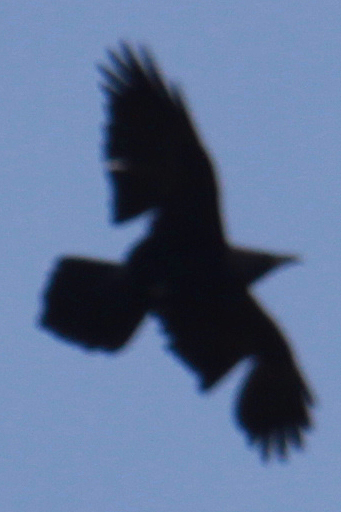
We saw this bird near Woodland Park today. The diamond-shaped tail indicates that this is a Common Raven (Corvus corax).
Posted by Rob Kiser on April 11, 2010 at 8:56 PM : Comments (0) | Permalink
April 10, 2010
Great-horned Owlets - Day 23
.jpg)
Above: Both Great-horned owlets sans mom.
My best estimate as to when the owlets were born is March 14-17, meaning that in this photo taken April 9th, the owlets would be approximately 23-26 days old.
Categories: Photos, Birds, Owls
Posted by Rob Kiser on April 10, 2010 at 11:27 AM : Comments (0) | Permalink
Immature Red-tailed Hawk
.jpg)
Above: Immature Red-tailed Hawk (Buteo jamaicensis) near Bear Creek Lake Park in Morrison, Colorado. The yellow eye in this image indicates an immature bird. Mature Red-tailed Hawks have a dark-brown eye.
Categories: Photos, Birds, Hawks
Continue reading "Immature Red-tailed Hawk"
Posted by Rob Kiser on April 10, 2010 at 11:01 AM : Comments (0) | Permalink
Mountain Bluebirds
.jpg)
Above: Male Mountain Bluebird (Sialia currucoides).
The Mountain Bluebirds are back. I've seen a few flitting around the fields recently, but this is the first half-decent shot I've managed to snap of them this year. The colors of these birds is really hard to describe. But, imagine looking outside for 9 months and seeing nothing but snow and then one day, this guy shows up. The color on this bird has not been altered in any way. This the exact color of the bird as the camera captured it this morning.
Posted by Rob Kiser on April 10, 2010 at 10:31 AM : Comments (2) | Permalink
April 8, 2010
Great-horned Owlets - Day 22
.jpg)
There is only one owlet in this photo, but there are two in the nest. The other owlet appears to be shy, and tends to hide beneath mom or in the bottom of the nest.
.jpg)
Above: Here's the rarely photographed reclusive sibling that hates to be in the spotlight. I found him on the back side of the nest, crouching down and peering out through the twigs. Hilarious.
My best estimate as to when the owlets were born is March 14-17, meaning that in this photo taken April 8th, the owlets would be approximately 22-25 days old.
Categories: Photos, Birds, Owls
Posted by Rob Kiser on April 8, 2010 at 8:50 PM : Comments (0) | Permalink
April 7, 2010
Great-horned Owlets - Day 21
.jpg)
My best estimate as to when the owlets were born is March 14-17, meaning that in this photo taken April 7th, the owlets would be approximately 21-24 days old.
Note that, in this image, for the first time, you can see the camouflage pattern of dark brown/buff stripes on the feathers, similar to the mother owl. So it appears the these owlets are rapidly progressing past the initial "down" feather stage.
Also, I only see one owlet in this photo. I'm not clear where the other owlet is. I can only assume he is beneath his mother's wing and is much more shy than his sibling.
Categories: Photos, Birds, Owls
Posted by Rob Kiser on April 7, 2010 at 3:28 PM : Comments (0) | Permalink
American Kestrels
.jpg)
Above: Today, I was fortunate enough to shoot a breeding pair of American Kestrels (Falco sparverius) in a tree near Morrison, Colorado. The male has blue/gray colored wings and is noticeably smaller than the female, as seen above.
.jpg)
Above: The female stuck around for a bit longer than the male, allowing me a slightly better photo of her.
Categories: Photos, Birds, Falcons
Posted by Rob Kiser on April 7, 2010 at 3:07 PM : Comments (0) | Permalink
April 6, 2010
Great-horned Owlets - Day 20
.jpg)
Although the owlets are now old enough that their mother leaves them to hunt for food when the weather is nice, in this photo, the mother Great-horned owl is blocking her two owlets from strong winds as a nasty snowstorm pushes in from the west.
My best estimate as to when the owlets were born is March 14-17, meaning that in this photo taken April 6th, the owlets would be approximately 20-23 days old.
Categories: Photos, Birds, Owls
Posted by Rob Kiser on April 6, 2010 at 2:50 PM : Comments (0) | Permalink
Mystery nest on bridge over Henry Fork of the Snake River
Mystery nest on bridge over Henry Fork of the Snake River near Idaho Falls, ID. I saw this nest on the way from Idaho Falls to St. Anthony National Sand Dunes. I would guess that it's an eagle's nest, but I'm not sure.
Update: It's an osprey nest.
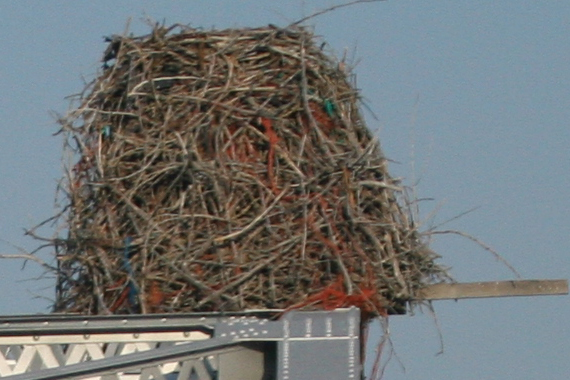
http://www.whatbird.com/forums/forums/147424/ShowThread.aspx#147424
Posted by Rob Kiser on April 6, 2010 at 11:04 AM : Comments (0) | Permalink
Great-horned Owlets - Day 19
.jpg)
Wendy and I got back from Moab on Sunday and yesterday (Monday), I went down the hill to check on the owlet because I'd not seen him for a few days. What a difference a few days makes. Not only is he growing like a weed, but he now has a sister, apparently. I had no clue that there were two owlets.
Actually, I was always surprised that there was only one owlet, as this would be an unusually small clutch size. (There are normally 2-3, I believe.)
But still, I was floored when I looked through the lens and saw two enormous owlets. I say they're brother and sister, but I have no clue what sex they are.
For the first time this year, both parents were absent from the nest. I believe that, at this point, the chicks are able to stay warm on their own. It was much warmer yesterday (about 58 °F), and they both have grown a significant amount of down/feathers.
Additionally, leaving the nest unattended frees up both parents to hunt for food for the baby owls. Needless to say, they appear to be well fed.
My best estimate as to when the owlets were born is March 14-17, meaning that in this photo taken April 5th, the owlets would be approximately 19-22 days old.
Categories: Photos, Birds, Owls
Posted by Rob Kiser on April 6, 2010 at 9:04 AM : Comments (0) | Permalink
April 5, 2010
Juvenile Bald Eagle in Glenwood Springs, CO
.jpg)
Here's a bird Wendy and I saw near Glenwood Springs yesterday. I'm not clear what it is. She thought it was a vulture. I thought it might be a hawk.
Update: This is a juvenile Bald Eagle (Haliaeetus leucocephalus).
Update 2: The bird is molting, which accounts for his shabby appearance.
http://www.whatbird.com/forums/forums/147199/ShowThread.aspx#147199
.jpg)
Continue reading "Juvenile Bald Eagle in Glenwood Springs, CO"
Posted by Rob Kiser on April 5, 2010 at 12:00 AM : Comments (0) | Permalink
April 4, 2010
Say's Phoebe in Moab
.jpg)
We saw this bird in Moab. I'm not clear what it is.
http://www.whatbird.com/forums/forums/147198/ShowThread.aspx#147198
Update: The bird is a Say's Phoebe (Sayornis saya).
.jpg)
Posted by Rob Kiser on April 4, 2010 at 11:36 PM : Comments (0) | Permalink
March 31, 2010
"Dark form" Red-tailed Hawk
.jpg)
This is the "Dark form" of the Red-tailed hawk (Buteo jamaicensis), a color pattern more common in the western United States. This color form has a reddish-brown breast with a darker "belly band", as opposed to the more common coloration of a white breast with reddish-brown streaks forming a prominent "belly band".
Posted by Rob Kiser on March 31, 2010 at 11:56 AM : Comments (0) | Permalink
"Dark form" Red-tailed Hawk over Aspen Park
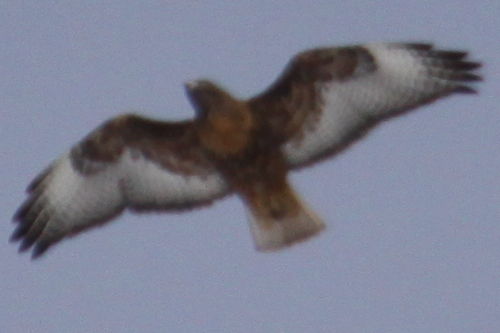
I saw this hawk flying yesterday over Aspen Park, Colorado. While I watched, it went from about 50 feet off the ground to so high it nearly disappeared. I would guess it was several hundred feet up in the air. I'm not clear what type of hawk it is. I think it's an Accipiter.
Update: H3ll no, it wasn't an Accipiter. It's the "Dark form" of the Red-tailed hawk (Buteo jamaicensis).
http://www.whatbird.com/forums/forums/146358/ShowThread.aspx#146358
Posted by Rob Kiser on March 31, 2010 at 3:47 AM : Comments (0) | Permalink
Great-horned Owlet - Day 13
.jpg)
In this photo, the mother owl has her head turned around backward, and the wind is blowing her feathers into the peculiar color pattern displayed on the breast.
Note that the owlet has begun to change colors from the initial white/gray morph to a color more closely matching the mother. Also, although the chick is squinting in this photo due to the bright sunlight, the chick can fully open its eyes at this point.
My best estimate as to when the owlet was born is March 14-17, meaning that in this photo taken March 30th, the owlet would be approximately 13-16 days old.
Categories: Photos, Birds, Owls
Posted by Rob Kiser on March 31, 2010 at 3:15 AM : Comments (0) | Permalink
March 27, 2010
Great-horned Owlet - Day 9
.jpg)
I went down yesterday to try to get some photos of the owlet. Mostly, they were sort of "UFO-Bigfoot quality photos", unfortunately. What I see is an owlet, that appears to be fairly mobile, living mainly beneath the mother's wing, but coming out to feed occasionally. I suspect that the father hunts at night for prey, brings it by and drops it off. Probably he does this all night. Then, around dawn, he flies off somewhere to perch and sleep through the day.
From the food the male brings, the mom eats some, but keeps a portion in the nest for the baby to munch on during the day. So, I think this is what I'm seeing...the baby coming out, getting a bit to eat from last night's kill, and then retreating to the warmth of the mother's wing. And it must be warm. Let there be no doubt about that. It's snowing outside, and somehow she keeps that baby warm as toast. I'm sure he's happy with the arrangement, so far as he understands it, anyway.
My best estimate as to when the owlet was born is March 14-17, meaning that in this photo taken March 26th, the owlet would be approximately 9-12 days old.
Categories: Photos, Birds, Owls
Posted by Rob Kiser on March 27, 2010 at 11:12 AM : Comments (0) | Permalink
Songbird
Today, Jen and I were outside playing in the snow and I heard this crazy songbird. His song was just amazing...beautiful, varied, loud, and lengthy. And I thought to myself..."what is that bird?"
I know from my bird research last year that it's a male singing, and he's trying to attract a mate. That's the primary reason songbirds sing. And it's springtime. So, I'm glad that I've noticed these little things going on in the world around me. Not that it matters, necessarily. Just that it feels cool to be informed. To be "in the loop", as it were.
So I walked around until I found out for sure what was singing and it was, to my surprise, a House finch (Carpodacus mexicanus). I've posted to Whatbird, as always.
.jpg)
Above: Male House Finch (Carpodacus mexicanus) on Wendy's feeder.
He sounded something like this (not my recording).
Update: Now that I'm looking at the photos I took of this bird, I'm not sure it's a House finch after all. I'm actually leaning toward a Cassin's Finch at this point.
Update 2: This bird has a bright red cap, and red frontal area, and lacks prominent brown streaking on the chest of a House finch. So, a Cassin's Finch it is. :)
.jpg)
Above: Male Cassin's Finch (Carpodacus cassinii).
.jpg)
Above: Male Cassin's Finch (Carpodacus cassinii).
.jpg)
Above: Male Cassin's Finch (Carpodacus cassinii).
Posted by Rob Kiser on March 27, 2010 at 10:41 AM : Comments (0) | Permalink
March 26, 2010
Red-tailed Hawk
.jpg)
.jpg)
.jpg)
Posted by Rob Kiser on March 26, 2010 at 10:24 AM : Comments (0) | Permalink
March 23, 2010
Red-tailed Hawk
.jpg)
Above: Mature Red-tailed Hawk (Buteo jamaicensis) flying through Cottonwood trees.
Posted by Rob Kiser on March 23, 2010 at 5:09 PM : Comments (0) | Permalink
Great-horned Owlet - Day 6
.jpg)
As best as I can tell, the mother only hatched one owlet this year. (Compared to 3 in 2009, and 2 in 2008). The eyes are possibly beginning to open somewhat at this point.
My best estimate as to when the owlet was born is March 14-17, meaning that in this photo taken March 23rd, the owlet would be approximately 6-9 days old.
Categories: Photos, Birds, Owls
Posted by Rob Kiser on March 23, 2010 at 4:25 PM : Comments (0) | Permalink
March 21, 2010
Great-horned Owlet - Day 4
.jpg)
Best guess at age clutch size this year is 1.
My best estimate as to when the owlet was born is March 14-17, meaning that in this photo taken March 21st, the owlet would be approximately 4-7 days old.
.jpg)
Categories: Photos, Birds, Owls
Posted by Rob Kiser on March 21, 2010 at 2:52 PM : Comments (0) | Permalink
March 16, 2010
Red-tailed Hawk
.jpg)
Above: Mature Red-tailed Hawk (Buteo jamaicensis) near Dakota Ridge Hogback in Morrison, Colorado.
Posted by Rob Kiser on March 16, 2010 at 9:59 AM : Comments (0) | Permalink
March 14, 2010
The American Robin
.jpg)
Above: American Robin (Turdus migratorius).
Posted by Rob Kiser on March 14, 2010 at 1:43 PM : Comments (0) | Permalink
March 12, 2010
Mountain Chickadee
.jpg)
Above: Mountain Chickadee (Poecile gambeli).
Posted by Rob Kiser on March 12, 2010 at 11:39 AM : Comments (0) | Permalink
March 7, 2010
Red-tailed Hawk
.jpg)
I saw this mature Red-tailed hawk down by the hogback this afternoon. It flew down and landed on the ground, presumably trying to catch something. But when it flew away, all I could see in the talons were leaves. So, maybe it was a near miss?
Posted by Rob Kiser on March 7, 2010 at 6:26 PM : Comments (0) | Permalink
Owlie
.jpg)
Jennifer said she thought she saw baby owls when she went by the nest, so I ran down and got this shot, but I have not seen any owlets yet.
Categories: Photos, Birds, Owls
Posted by Rob Kiser on March 7, 2010 at 6:18 PM : Comments (0) | Permalink
Bald Eagle
.jpg)
Above: This Bald Eagle (Haliaeetus leucocephalus) flew over my house today. Robert and I were out taking photos of a Red-tailed hawk, when Robert pointed out this bird, flying much higher up.
Posted by Rob Kiser on March 7, 2010 at 2:43 PM : Comments (2) | Permalink
March 2, 2010
Owlie
.jpg)
Above: Great Horned Owl (Bubo virginianus) incubating clutch of eggs near Morrison, Colorado.
I stopped by to check on "Owlie". He/she seems to be healthy, happy, and warm, but no sign of the owlets yet.
Categories: Photos, Birds, Owls
Posted by Rob Kiser on March 2, 2010 at 9:40 PM : Comments (0) | Permalink
Magpie Nest
.jpg)
I first noticed this aberration last year. Or possibly the year before. But I've decided that it's a Magpie's nest. Not only does it look like photos of other Magpie nests, but I saw a Magpie in the small tree today. So that's my story and I'm sticking with it.
.jpg)
Posted by Rob Kiser on March 2, 2010 at 9:15 PM : Comments (0) | Permalink
March 1, 2010
Pendant Nests
.jpg)
Wendy pointed out some nests when we were driving down the hogback the other day. She has a way of doing that...of pointing out things to me that I'd generally just sort of ignore as noise in the system. She was like "I wonder what makes that nest?"
And I didn't really have an answer. But I do see a lot of these nests around the hogback. They remind me of the long, hanging, woven nests of the Oropendola birds in Peru. So I did a little research on it. It turns out that this type of nest is called a "Pendant Nest".
Whatbird indicates that the nests in question look similar to the nests made by a Bushtit or an Oriole. Apparently, we have Bushtits, Orchard Orioles, and Bullock's Orioles in Colorado. The Orioles are larger birds (about 7"-8"), whereas the Bushtit is a much smaller bird (4 1/2").
So, probably the only way to tell the difference would be from the size of the nest, or seeing the birds leaving the nests.
Update: I suspect that these are Bushtit nests, because I don't think they're big enough for an Oriole.
.jpg)
Posted by Rob Kiser on March 1, 2010 at 7:39 PM : Comments (0) | Permalink
"Dark form" Red-tailed Hawk
.jpg)
Above: "Dark form" of the Red-tailed hawk (Buteo jamaicensis). Most Red-tailed hawks I see have light chests with dark brown streaks. Because this bird has an almost completely brown chest, it appears to be a "dark form" of the bird, one of the many races of Red-tailed hawks.
Posted by Rob Kiser on March 1, 2010 at 3:52 PM : Comments (1) | Permalink
February 28, 2010
Immature Red-tailed Hawk
.jpg)
Above: Immature Red-tailed hawk (Buteo jamaicensis) near Morrison, Colorado. Note the distinct narrow bands on the tail feathers which are much less pronounced at maturity.
http://www.whatbird.com/forums/forums/141212/ShowThread.aspx#141212
Posted by Rob Kiser on February 28, 2010 at 6:30 PM : Comments (0) | Permalink
February 26, 2010
Canon Extender EF 1.4X II (Teleconverter)
My new toy came today via UPS. Woohoo! I'm going to try to get some shots of owlie when I go to pick up Jennifer today. Hopefully, I'll get better shots of owlie. We'll see.
I'm trying to get some rough depth-of-field calculations, this is always tricky with smaller-than-full-frame sensors. My sensor has a 1.6X "crop factor". But the lens is a 100mm - 400mm L-series lens designed for a full frame sensor. You can tell this silly DOF calculator that you're shooting a Canon EOS 50D, so it knows to accomodate for the 1.6X "crop factor", but then there are two different types of lenses you can use for this frame, the EF, and the EFS. The EFS lenses are designed for the smaller sensor, the EF lenses are not. So, this is sort of a crap shoot.
Update: So, the autofocus doesn't work at all with the extender. I had thought that this might be a possibility. Not very convenient, but I figured I should be able to manually focus my camera, although I readily admit it's not something I have a lot of practice with.
Update: I tricked the camera and now the autofocus works. :)
.jpg)
Above: Great-horned Owl (Bubo virginianus).
.jpg)
Above: The American Kestrel (Falco sparverius).
Categories: Photos, Birds, Owls, Falcons
Posted by Rob Kiser on February 26, 2010 at 2:21 PM : Comments (0) | Permalink
February 20, 2010
Dark-eyed Junco
.jpg)
Above: Male Oregon form of the Dark-eyed Junco (Junco hyemalis) near Morrison, Colorado.
http://www.whatbird.com/forums/forums/140049/ShowThread.aspx#140049
Posted by Rob Kiser on February 20, 2010 at 8:23 PM : Comments (0) | Permalink
Raptors in a snowstorm
.jpg)
Above: Mature Red-tailed Hawk (Buteo jamaicensis) perched in a tree near Morrison, Colorado.
I wanted to see what the hawks did in a snow storm. Not much different than their normal activity, so far as I can tell. They puff up more. Tend to stay closer to the tree trucks, possibly. But the weather really doesn't seem to bother them.
.jpg)
Above: Mature Red-tailed Hawk (Buteo jamaicensis) perched in a tree near Morrison, Colorado.
.jpg)
Above: Mature Red-tailed Hawk (Buteo jamaicensis) perched in a tree near Morrison, Colorado.
Posted by Rob Kiser on February 20, 2010 at 8:18 PM : Comments (2) | Permalink
February 18, 2010
Owlie in the snow
.jpg)
Above: Here, we see the Great Horned Owl (Bubo virginianus) patiently incubating a clutch of eggs in a Red-Tailed Hawk's nest in the snow. If you look closely, you'll see that the back of the owl's neck is covered with a bit of snow. These birds are obviously well insulated.
I drove around for a bit this afternoon as I wanted to see what the raptors did in a snowstorm. Surprisingly, they didn't seem to behave any differently than they do on any other day. I saw some hawks flying around, presumably scouting for a meal. Saw a few hawks perching on trees in the snow. Saw the owl in the nest incubating the eggs. Basically, the raptors that I observed acted exactly the same as if it were clear and sunny, so far as I could tell.
Categories: Photos, Birds, Owls
Posted by Rob Kiser on February 18, 2010 at 10:15 PM : Comments (0) | Permalink
February 16, 2010
The Daily Raptors
.jpg)
Above: Great Horned Owl (Bubo virginianus) incubating a clutch of eggs near Morrison, Colorado.
.jpg)
Above: Mature Red-tailed Hawk (Buteo jamaicensis) near Morrison, Colorado.
.jpg)
Above: Mature Red-tailed Hawk (Buteo jamaicensis) near Morrison, Colorado.
Categories: Photos, Birds, Owls
Posted by Rob Kiser on February 16, 2010 at 5:38 PM : Comments (0) | Permalink
February 15, 2010
Hawk Watch on the Hogback
.jpg)
Above: Mature Red-tailed hawk (Buteo jamaicensis) transitions from perching to flying near Morrison, Colorado.
I was reading Mary Taylor Gray's Guide to Colorado Birds and saw this birding tip about some "Hawk Watch" up on the Dakota Ridge Hogback. So Wendy drove me up there and, I have to say, we saw scads of Red-tailed Hawks. They seemed to be everywhere. Now, granted, we never technically found the Official Hawk Watch headquarters (Update: I think it's here). And we spent most of the time in the truck driving around and shooting from the shoulder, and we didn't take too many photos before we retired to the Morrison Inn for margs.
"Why is no one here?" Wendy asked.
"I dunno. It's a Monday. It's 4:00 p.m. People have jobs, I guess?"
"Hmmm. I guess."
But we saw lots of hawks. No doubt about that.
Continue reading "Hawk Watch on the Hogback"
Posted by Rob Kiser on February 15, 2010 at 7:01 PM : Comments (0) | Permalink
Great Horned Owl Incubating Eggs
.jpg)
Above: Great Horned Owl (Bubo virginianus) incubates a clutch of eggs. My guestimation is that they will hatch on or around March 11th.
Categories: Photos, Birds, Owls
Posted by Rob Kiser on February 15, 2010 at 6:48 PM : Comments (0) | Permalink
February 12, 2010
Mature Rough-legged Hawk
.jpg)
Above: Mature Rough-legged Hawk (Buteo lagopus) soaring above the Roaring Fork River south of Glenwood Springs, Colorado.
.jpg)
Above: Mature Rough-legged Hawk (Buteo lagopus) soaring above the Roaring Fork River south of Glenwood Springs, Colorado.
http://www.whatbird.com/forums/forums/138856/ShowThread.aspx#138856
Posted by Rob Kiser on February 12, 2010 at 7:42 PM : Comments (0) | Permalink
Red-Tailed Hawk
.jpg)
Above: Mature Red-tailed Hawk (Buteo jamaicensis) soaring above the Roaring Fork River south of Glenwood Springs, Colorado.
.jpg)
Above: Mature Red-tailed Hawk (Buteo jamaicensis) soaring above the Roaring Fork River south of Glenwood Springs, Colorado.
http://www.whatbird.com/forums/forums/138851/ShowThread.aspx#138851
Posted by Rob Kiser on February 12, 2010 at 7:34 PM : Comments (0) | Permalink
February 10, 2010
Mature Red-tailed Hawk
.jpg)
I saw this Red-tailed Hawk (Buteo jamaicensis) this afternoon near Lakewood, Colorado. I see fading narrow tail bands and white mottling on the wings. Immature Red-tailed hawks have tail bands, which are absent at maturity. This appears to be an immature bird due to the mottling and fading tail bands.
Update: My understanding now is that this is possibly a mature bird, as the white wing mottling is normal for adults and the tail bands never completely go away.
http://www.whatbird.com/forums/forums/138543/ShowThread.aspx#138543
Posted by Rob Kiser on February 10, 2010 at 6:56 PM : Comments (0) | Permalink
Owlie's Back :)
.jpg)
I thought I saw that the owl was back last week, and then Wendy told me on Sunday for sure that there was definitely an owl back in the nest. I'm not sure how long they have been nesting. My guess is that they have been there for about a week. Wendy says she saw them 3 weeks ago.
The incubation period for a Great Horned Owl (Bubo virginianus) is reportedly 28-35 days, with 33 being the average. The owlets will then reportedly fledge at 35 days. Of course, I have no idea where we are in the process.
I'm led to believe that both male and female incubate the eggs. The Great Horned Owls do not exhibit sexual dimorphism in their plumage, but the females may be slightly larger than males.
Categories: Photos, Birds, Owls
Continue reading "Owlie's Back :)"
Posted by Rob Kiser on February 10, 2010 at 6:36 PM : Comments (0) | Permalink
January 31, 2010
House Sparrows
.jpg)
Above: Male and female House Sparrow (Passer domesticus) breeding in Old Salem, North Carolina.
http://www.whatbird.com/forums/forums/thread/136661.aspx
View my other bird photos.
Posted by Rob Kiser on January 31, 2010 at 9:24 AM : Comments (0) | Permalink
January 20, 2010
Redhead
.jpg)
Above: Redhead (Aythya americana) drake in non-breeding plumage near Jackson, Wyoming. Sept 17th, 2006. From July - September, Redhead drakes exhibit non-breeding plumage when the black breast feathers are noticeably absent.
Posted by Rob Kiser on January 20, 2010 at 11:01 PM : Comments (0) | Permalink
Sitting Ducks
.jpg)
Above: Common Goldeneye (Bucephala clangula) duck (female).
I dropped off Jennifer for her piano lesson and, seeing as I had about a half an hour to kill, I went down and shot some ducks on Bear Creek. The light was too dim, plus I had the Image Stabilization set on Mode 2, which is a nice effect when it works properly. Unfortunately, there wasn't enough light to accomplish the trick I was going for. So, here are some photos of ducks, but they're nothing special. I present them mainly for identification purposes.
.jpg)
Above: Common Goldeneye (Bucephala clangula) drake.
.jpg)
Above: Breeding pair of Hooded Mergansers (Lophodytes cucullatus).
.jpg)
Above: Common Goldeneye (Bucephala clangula) drake.
.jpg)
Above: Breeding pair of Common Goldeneyes (Bucephala clangula).
.jpg)
Above: Breeding pair of Common Goldeneyes (Bucephala clangula).
http://www.whatbird.com/forums/forums/135313/ShowThread.aspx#135313
Posted by Rob Kiser on January 20, 2010 at 8:00 PM : Comments (0) | Permalink
January 14, 2010
Blue Jay
.jpg)
Above: Blue Jay (Cyanocitta cristata) in Ken Caryl Canyon, near Littleton, Colorado.
Posted by Rob Kiser on January 14, 2010 at 9:13 PM : Comments (0) | Permalink
American Kestrel (Female)
.jpg)
Above: Female American Kestrel (Falco sparverius) near Littleton, Colorado.
Categories: Photos, Birds, Falcons
Posted by Rob Kiser on January 14, 2010 at 8:11 PM : Comments (0) | Permalink
American Kestrel (Male)
.jpg)
.jpg)
.jpg)
.jpg)
Above: Male American Kestrel (Falco sparverius) near Lakewood, Colorado.
Categories: Photos, Birds, Falcons
Posted by Rob Kiser on January 14, 2010 at 6:49 PM : Comments (0) | Permalink
Hooded Merganser
.jpg)
Above: Hooded Merganser (Lophodytes cucullatus) drake near Lakewood, Colorado.
Posted by Rob Kiser on January 14, 2010 at 6:37 PM : Comments (0) | Permalink
January 13, 2010
American Kestrel
.jpg)
Above: I spotted this American Kestrel (Falco sparverius) this morning near Morrison, Colorado. I've tentatively identified it as a female due to multiple black bands across the tail. Update from: WhatBird.com - She's a she:
"This is a female. Note the blurry rufous chest barring vs. definite black chest spots." and "The more obvious mark is that the male has blue wings rather than the black striped rufous ones on these birds. Also, along with the difference in the markings on the underside, the back of the male lacks the stripes, and instead has more sparse black chevrons near the rear of his back."
Previous American Kestrel photo.
Categories: Photos, Birds, Falcons
Continue reading "American Kestrel"
Posted by Rob Kiser on January 13, 2010 at 10:11 AM : Comments (0) | Permalink
January 10, 2010
Carolina Wren
.jpg)
Above: Carolina Wren (Thryothorus ludovicianus) near Madison, MS.
http://www.whatbird.com/forums/forums/133705/ShowThread.aspx#133705
Posted by Rob Kiser on January 10, 2010 at 5:12 PM : Comments (0) | Permalink
Carolina Chickadee
.jpg)
Above: Carolina Chickadee (Parus carolinensis) near Madison, MS.
Posted by Rob Kiser on January 10, 2010 at 2:30 PM : Comments (0) | Permalink
Golden-crowned Kinglet
.jpg)
Female Golden-crowned Kinglet (Regulus satrapa) near Madison, MS.
Posted by Rob Kiser on January 10, 2010 at 1:53 PM : Comments (0) | Permalink
Wood Thrush
.jpg)
Wood Thrush (Hylocichla mustelina) near Madison, MS.
Posted by Rob Kiser on January 10, 2010 at 1:49 PM : Comments (0) | Permalink
Yellow-bellied Sapsucker
.jpg)
Yellow-bellied Sapsucker (Sphyrapicus varius) near Madison, MS.
Posted by Rob Kiser on January 10, 2010 at 1:39 PM : Comments (0) | Permalink
Red-bellied Woodpecker
.jpg)
.jpg)
.jpg)
Above: Female Red-bellied Woodpecker (Melanerpes carolinus) near Madison, MS.
Posted by Rob Kiser on January 10, 2010 at 1:20 PM : Comments (0) | Permalink
Red-headed Woodpecker
.jpg)
Red-headed Woodpecker (Melanerpes erythrocephalus) near Madison, MS.
Posted by Rob Kiser on January 10, 2010 at 1:14 PM : Comments (0) | Permalink
Wood Duck
.jpg)
Wood Duck (Aix sponsa) in Jackson, MS.
Posted by Rob Kiser on January 10, 2010 at 1:06 PM : Comments (0) | Permalink
Tufted Titmouse
.jpg)
.jpg)
Tufted Titmouse (Baeolophus bicolor) in Madison, MS.
Posted by Rob Kiser on January 10, 2010 at 12:53 PM : Comments (0) | Permalink
Great Blue Heron
.jpg)
Great Blue Heron (Ardea herodias) flying above the Pearl River near Jackson, MS.
http://www.whatbird.com/forums/forums/post/132897.aspx
Posted by Rob Kiser on January 10, 2010 at 12:43 PM : Comments (0) | Permalink
Red-tailed Hawk
.jpg)
.jpg)
.jpg)
Mature Red-tailed Hawk (Buteo jamaicensis) in Morrison, Colorado.
Posted by Rob Kiser on January 10, 2010 at 12:15 PM : Comments (0) | Permalink
December 25, 2009
Northern Shrike (Lanius excubitor)
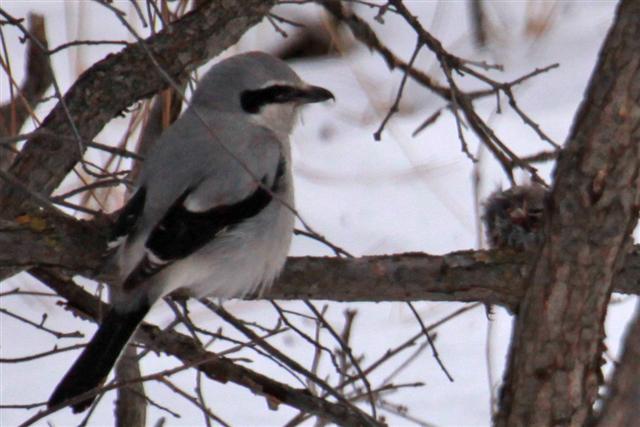
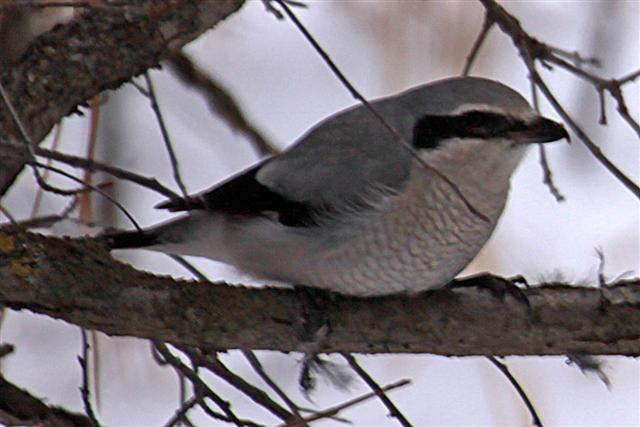
So I was looking outside my window this morning and I saw this little grey bird with a dark eye patch fighting with another bird. Or so I thought. On closer inspection, I saw that he was actually eating the other bird, which appears to be a male house finch. I'm not surprised, really. There's not a lot of food up here in the winter time, or there doesn't appear to be, anyhow.
I couldn't really understand what was keeping the bird from falling. Couldn't see what was sustaining the weight of the bird as it was being devoured.
So I grabbed a stack of Colorado bird books and identified this carnivore as a Loggerhead Shrike, aka "Butcher Bird". It says that his feet aren't strong enough to hold his prey, and they're known to skewer their meals on barbed wire, thorns, anything to keep it suspended while they devour their prey. And sure enough, I went out to investigate and discovered that he'd skewered the bird to the scrub oaks.
Update: I had initially identified this bird at a Loggerhead Shrike (Lanius ludovicianus). After posting to Whatbird.com, I've been corrected. The bird is actually a Northern Shrike (Lanius excubitor), which I caught by chance at the very southern end of their range, in the dead of winter.
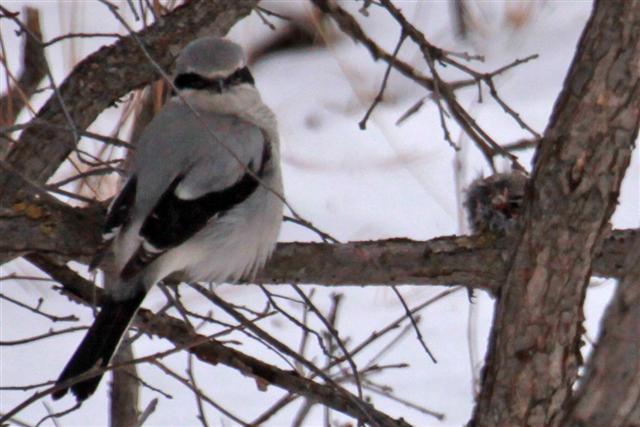
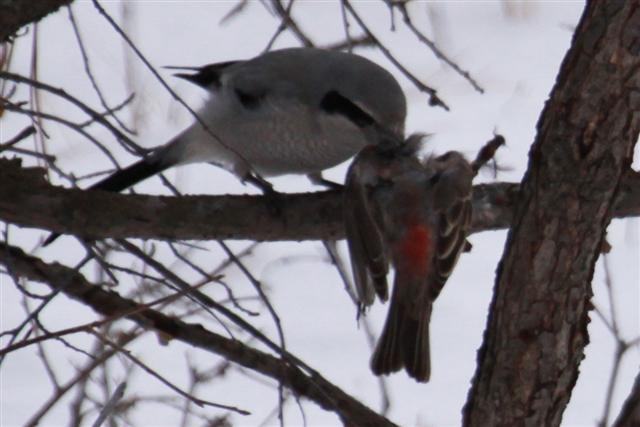
Posted by Rob Kiser on December 25, 2009 at 2:17 PM : Comments (0) | Permalink
December 20, 2009
Female Northern Harrier
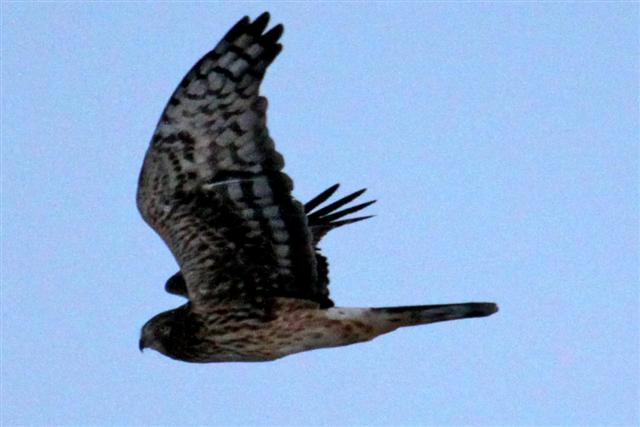
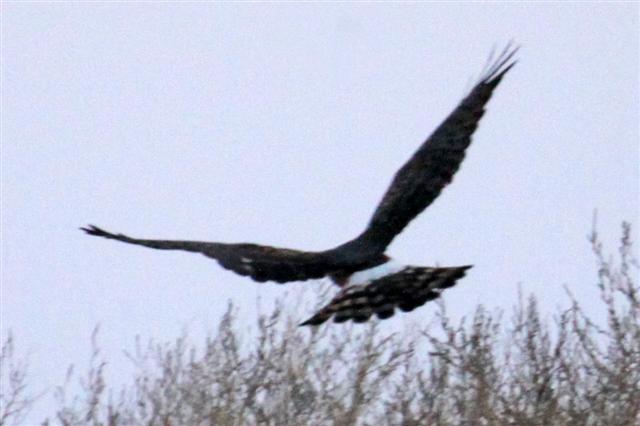
Female Northern Harrier (Circus cyaneus) near Hill City, Kansas.
Posted by Rob Kiser on December 20, 2009 at 11:53 PM : Comments (0) | Permalink
September 3, 2009
Female Eclectus Parrot
A woman came into work today with this bird. I believe she said it was a female Eclectus Parrot.
Posted by Rob Kiser on September 3, 2009 at 1:27 AM : Comments (0) | Permalink
July 31, 2009
Rufous Hummingbird
.jpg)
Above: Male Rufous Hummingbird (Selasphorous rufus),
.jpg)
Above: Male Rufous Hummingbird (Selasphorous rufus),
.jpg)
Above: Female Rufous Hummingbird (Selasphorous rufus),
.jpg)
Above: Female Rufous Hummingbird (Selasphorous rufus),
.jpg)
Above: Female Rufous Hummingbird (Selasphorous rufus),
Posted by Rob Kiser on July 31, 2009 at 8:22 PM : Comments (0) | Permalink
July 15, 2009
One to One
.jpg)
Above: I finally mixed my sugar to water as a 1:1 ratio. As in, I dissolved 1 cup of sugar in 1 cup of boiling water. I used use 1 part sugar to 3 parts water. Or even 1:4 (gasp).
This is why I never had the full-on dog-fights over my feeders, but I finally clued in and now, it's standing room only at the feeders. Dangerous to go outside, even. I was so excited today when I saw the first Rufous Hummingbird (Selasphorous rufus) on my feeder. I grabbed my camera and snapped a few pics, only to realize that my Rufous Hummingbird was actually just a female Broad-tailed Hummingbird (Selasphorus platycercus platycercus).
Above: I shot this flower at Jeanelle's. No clue what it is.
.jpg)
Above: Female Broad-tailed Hummingbird (Selasphorus platycercus platycercus) on Wendy's feeder.
.jpg)
Above: Male Rufous Hummingbird (Selasphorous rufus) on Wendy's feeder.
.jpg)
Above: Male Rufous Hummingbird (Selasphorous rufus) on Wendy's feeder.
.jpg)
Above: Male Rufous Hummingbird (Selasphorous rufus) on Wendy's feeder.
Posted by Rob Kiser on July 15, 2009 at 11:05 PM : Comments (0) | Permalink
June 29, 2009
Swainson's Hawk
.jpg)
Swainson's Hawk (Buteo swainsoni) with light color morph soaring over a field near the hogback. Here's my post at whatbird.com. Granted, this photo isn't very good, but so far as I know, this is the first Swainson's Hawk I've ever seen. I used to assume that all the hawks I saw were Red-tailed Hawks. Now, when I see a bird overheard, I take a shot and then when I get home, I try to identify it.
Categories: Photos, Birds, Hawks
Posted by Rob Kiser on June 29, 2009 at 12:30 AM : Comments (0) | Permalink
June 21, 2009
Cooper's Hawk
This is not a great photo, but this Cooper's Hawk (Accipiter cooperii) flew over the house yesterday. Wendy pointed it out and I just assumed it was a Red-tailed Hawk. But upon closer inspection, I believe that it's a Cooper's Hawk. The long narrow tail gives it away as an accipiter. The rounded tail and the overall size mean it's a Cooper's as opposed to a Sharp-shinned Hawk.
Posted by Rob Kiser on June 21, 2009 at 9:52 AM : Comments (0) | Permalink
June 5, 2009
Daily Photos (Updated)
.jpg)
Finally, a photo of the Great Horned owlets with a parent in the nest for perspective.
Update: Haha. I'm sitting here drinking a beer and looking at my website and I looked at this photo again and I was like....Holy Sh1t, Batman...there's three baby owls in this photo. Apparently, their average clutch size is 2.3 owlets. So, in this case, we got 3. Haha. Cracks me up. I've been shooting these owlets for some time, and I suspected that there might be more than two, as, if you go back and look at some of the older photos, I did notice shapes that were hard to explain. But this is classic. Three baby owlets with a parent and all four of them looking into the frame. Luck counts. I'll take it.
.jpg)
The House Wren has laid yet another egg for a total of eight. She's been laying an egg a day now for as long as I can remember.
.jpg)
Jennifer checking one of the nests. We take the four wheeler because it's the easiest way to gain access to the nests. It's basically a rolling ladder. We just stand up on the game rack on the front.
.jpg)
Photos of the flowers at the local country club. No clue what they are. Update: Chick Voice points out that these are Lupines. Thanks CV.
.jpg)
More photos of the flowers at the local country club. No clue what they are. Update: Chick Voice points out that these are Pink Columbines. Thanks CV.
Categories: Photos, Birds, Owls
Posted by Rob Kiser on June 5, 2009 at 7:16 PM : Comments (2) | Permalink
June 3, 2009
Daily Bird Photos
.jpg)
The House Wren added yet another egg to her clutch. I have to think she'll stop laying eggs and start incubating them in the next day or so. Both Western Bluebird moms are incubating their eggs.
.jpg)
The owlets look a little dryer today than yesterday.
.jpg)
Broad-tailed Hummingbird on Mountain Lilac. Walking outside is pretty much like taking your life in your own hands. These things dogfight all day and they've buzzed me a few times which is pretty scary. They come buzzing about 12" from your face going about 30 mph. It's pretty intense.
Categories: Photos, Birds, Owls
Posted by Rob Kiser on June 3, 2009 at 8:17 PM : Comments (0) | Permalink
June 2, 2009
Female Broad-tailed Hummingbird
.jpg)
Female Broad-tailed Hummingbird (Selasphorus platycercus) on Mountain Lilac.
Posted by Rob Kiser on June 2, 2009 at 4:48 PM : Comments (0) | Permalink
Great Horned Owlets in a Rain Storm
.jpg)
I went down to check in on the owlets this morning. After the rain we got last night, I bet the owlets were wishing they had a roof. They're soaking wet in this photo. Parents were not in sight.
Categories: Photos, Birds, Owls
Posted by Rob Kiser on June 2, 2009 at 2:57 PM : Comments (0) | Permalink
Bluebird Trail - 23 eggs and counting
Bird House #1: (Not shown) None of the six Mountain Chickadee (Poecile gambeli) eggs/hatchlings survived. Not sure why.
.jpg)
Bird House #2: (Above) The House Wrens (Troglodytes aedon) have added yet another egg to their nest, bringing the total to five pink eggs.
.jpg)
Bird House #3: (Above) Today, there were five Western Bluebird eggs, and we didn't see mom. So that makes me think that she was laying an egg when I spotted her on the nest yesterday, not incubating them. If this theory holds, then she may lay another egg today, or else begin incubation.
Bird House #4: (Not shown) Unoccupied.
.jpg)
Bird House #5: (Above) Still contains seven tiny white bird eggs. Species unknown. The mother is not incubating these eggs. This nest may have been abandoned.
.jpg)
Bird House #6: (Above) The mom Western Bluebird (Sialia mexicana) flushed from the nest when I pulled up today. She's incubating six little blue eggs.
Posted by Rob Kiser on June 2, 2009 at 2:44 PM : Comments (0) | Permalink
June 1, 2009
Bluebird Trail
.jpg)
Bird House #1: (Above) The sole survivors of the Mountain Chickadees (Poecile gambeli) brood is hanging in there like a hair in a biscuit.
.jpg)
Bird House #2: (Above) The House Wrens (Troglodytes aedon) have added another egg (and some Stellar Jay feathers) to their nest, bringing the total to four pink eggs.
.jpg)
Bird House #3: (Above) The Western Bluebird mom started incubating her eggs today. I believe that she's sitting on four eggs, although it is possible that there are five.
Bird House #4: (Not shown) Unoccupied.
Bird House #5: (Not shown) Still contains seven tiny white bird eggs. Species unknown. The mother is not incubating these eggs. This nest may have been abandoned.
.jpg)
Bird House #6: (Above) The mom Western Bluebird (Sialia mexicana) flushed from the nest when I pulled up today. She's incubating six little blue eggs.
Posted by Rob Kiser on June 1, 2009 at 2:05 PM : Comments (2) | Permalink
Mystery Colorado Songbird
.jpg)
This bird was singing in the top of one of my neighbor's Ponderosa Pine trees. The song was just unbelievable, so I went out and shot some photos of him. No recording of his song, unfortunately. The bird is a perching songbird with a heavy bill for eating seeds from pine cones. I've posted an identification help request on whatbird.com. Update: After going through my "Guide to Colorado Birds by Mary Taylor Gray", I've identified this bird as a male Black-headed Grosbeak (Pheucticus melanocephalus) in breeding plumage.
.jpg)
Posted by Rob Kiser on June 1, 2009 at 12:11 PM : Comments (0) | Permalink
May 31, 2009
Bluebird Trail
.jpg)
Bird House #1: (Above) The Mountain Chickadees (Poecile gambeli) don't look like they're doing very well. Today, there was only one live chick in there. Apparently the parents had hauled off the remainder of the egg shells and dead chicks. I think that there were originally six eggs. So, their survival rate is roughly what you'd see in a third-world country. Hopefully this chick makes it.
.jpg)
Bird House #2: (Above) This bird house is perched atop Jennifer's swing set. Yesterday, it contained two pink bird eggs. Today, it contains three pink bird eggs. Species unknown. Update: Based on photos on this website, I'm thinking that these eggs may belong to a pair of House Wrens(Troglodytes aedon).
.jpg)
Bird House #3: (Above) This bird house is mounted to the front garden fence. Yesterday, it contained three Bluebird eggs. Today, it contains four Bluebird eggs. This is either a Mountain Bluebird or a Western Bluebird. I believe that I saw the parents today and they appear to be Western Bluebirds.
Bird House #4: (Not shown) This bird house is mounted to the back garden fence. It is unoccupied.
Bird House #5: (Not shown) This bird house is mounted to a dead mature Ponderosa pine in the back. It contains seven tiny white bird eggs. No change from yesterday. Species unknown.
.jpg)
Bird House #6: (Above) This bird house is on a pole in Bud's front yard. At last count, she was sitting on six eggs, but she won't leave them now, so I'm not clear how many are under her or how many (if any) have hatched. This appears to be a nest of Western Bluebirds (Sialia mexicana).
Posted by Rob Kiser on May 31, 2009 at 2:13 PM : Comments (0) | Permalink
Red-winged Blackbird
.jpg)
Mature male Red-winged Blackbird (Agelaius phoeniceus) in breeding plumage .
Posted by Rob Kiser on May 31, 2009 at 3:28 AM : Comments (1) | Permalink
May 23, 2009
Great Horned Owlets
.jpg)
Two Great Horned owlets (Bubo virginianus). This is the best photo of baby owls I've taken this year. They're so big that the mother stays in an adjacent tree. My guess is that they'll fledge pretty soon.
Categories: Photos, Birds, Owls
Posted by Rob Kiser on May 23, 2009 at 5:26 PM : Comments (0) | Permalink
Western Meadowlark
.jpg)
Western Meadowlark (Sturnella neglecta). The meadowlark has a long, pointed bill used for catching grasshoppers, caterpillars, and beetles.
Posted by Rob Kiser on May 23, 2009 at 4:17 PM : Comments (0) | Permalink
May 17, 2009
Spectacled Owl
.jpg)
We saw this Spectacled owl (Pulsatrix perspicillata) at a birds of prey exhibit at The Fort in Morrison today. They are native to Central America.
Posted by Rob Kiser on May 17, 2009 at 11:07 PM : Comments (0) | Permalink
Great Horned Owlet
.jpg)
Here's a photo of the Great Horned Owlet that I shot today. This one looks a little better than the last one, but not by a great margin. You can see one of the owlet's eyes, and his (or her) beak. I'm surprised by how quickly the bird is maturing.
Categories: Photos, Birds, Owls
Posted by Rob Kiser on May 17, 2009 at 11:00 PM : Comments (1) | Permalink
May 10, 2009
Great Horned Owlet
.jpg)
Yesterday, when I brought Jennifer home from the airport, we stopped to check on the Great Horned Owl nest and, for the first time this year, I spotted a baby owl. The owlet is snow white and appears to be covered in down. The baby was eating something when I spotted him. I snapped a few Bigfoot/UFO quality photos of the baby, but you can see the little bugger if you look closely. It's the white little furry thing behind the momma owl.
Categories: Photos, Birds, Owls
Posted by Rob Kiser on May 10, 2009 at 11:00 PM : Comments (1) | Permalink
April 27, 2009
Birds on the Feeder
.jpg)
Saw these birds on Wendy's feeder this weekend. The birds shown are a a male Evening Grosbeak (above),a male Crossbill, and male and female Downy Woodpecker.
.jpg)
.jpg)
.jpg)
.jpg)
.jpg)
Posted by Rob Kiser on April 27, 2009 at 9:06 AM : Comments (0) | Permalink
April 11, 2009
Great Horned Owl
.jpg)
Great Horned Owl (Bubo virginianus) incubating eggs near Morrison, Colorado.
Categories: Photos, Birds, Owls
Posted by Rob Kiser on April 11, 2009 at 6:45 PM : Comments (0) | Permalink
Laughing Gull
Second winter Laughing Gull(Leucophaeus atricilla) on Pensacola Beach, Florida. August 2008.
View other bird photos.
Posted by Rob Kiser on April 11, 2009 at 8:57 AM : Comments (0) | Permalink
April 10, 2009
Red-tailed Hawk
.jpg)
Red-tailed hawk (Buteo jamaicensis) near Morrison, Colorado.
.jpg)
View other bird photos.
Posted by Rob Kiser on April 10, 2009 at 5:32 PM : Comments (0) | Permalink
American Kestrel
.jpg)
American Kestrel (Falco sparverius) near Morrison, Colorado.
Categories: Photos, Birds, Falcons
Posted by Rob Kiser on April 10, 2009 at 1:22 PM : Comments (0) | Permalink
April 8, 2009
Canadian Goose
.jpg)
A banded Canadian Goose (Branta canadensis) stretches his wing on a small island in Lake Evergreen.
Posted by Rob Kiser on April 8, 2009 at 12:31 PM : Comments (0) | Permalink
April 7, 2009
Western Meadowlark
.jpg)
Male Western Meadowlark (Sturnella neglecta).
View other bird photos.
Posted by Rob Kiser on April 7, 2009 at 1:58 PM : Comments (0) | Permalink
March 31, 2009
Heading to Moab
.jpg)
Got a few shots of a Bald Eagle hunting above the Colorado River today. The eagles have a protected nesting area in the Glenwood Canyon. We swam around in the hot springs in Glenwood Springs and then crashed for the night. We're on to Moab tomorrow with two four wheelers in tow.
.jpg)
Posted by Rob Kiser on March 31, 2009 at 7:19 PM : Comments (0) | Permalink
November 1, 2008
Downy Woodpecker
.jpg)
Male Downy Woodpecker(Picoides pubescens) on a Ponderosa Pine stump.
Posted by Rob Kiser on November 1, 2008 at 8:21 PM : Comments (0) | Permalink
October 10, 2008
Timmy's Fifth Bird
Timmy caught his fifth bird today. This is a Red-Breasted Nuthatch(Sitta canadensis).
He's been catching about one a day here lately, it seems. I think he's catching them out of the bird bath, so possibly I should move it so that he can't pounce on them when they're drinking. So far, we've released three that lived. I found one dead in the house, and then there was one that was MIA - I just found a bunch of feathers on that one.
Posted by Rob Kiser on October 10, 2008 at 8:15 PM : Comments (0) | Permalink
September 28, 2008
Timmy's First Catch
Timmy caught his first bird today. He was so proud he came running in through the cat door with it in his mouth. I was watching MSNBC explain how Obama was going to cut taxes and make everything free from health care to college to marshmallows and I wasn't really paying much attention to the cat. Even when the bird started singing, I convinced myself that it was some squeaky toy Jennifer had given the cat. But when I saw the bird hopping across the tile floors in the kitchen, I was like..."WTF is that?"
I saved it from Timmy and looked it up in my bird book. It appears to be an immature female Lesser Goldfinch(Carduelis psaltria), but I'm attempting to verify this at www.whatbird.com.
Update: I was mistaken about the bird identification. The shape of the bill indicates it is a Warbler, and the coloration leads to the conclusion that this is a MacGillivray's Warbler (Oporornis tolmiei).
Continue reading "Timmy's First Catch"
Posted by Rob Kiser on September 28, 2008 at 1:57 PM : Comments (0) | Permalink
August 11, 2008
Double-crested Cormorant
.jpg)
Double-crested Cormorant (Phalacrocorax auritus).
Posted by Rob Kiser on August 11, 2008 at 11:30 PM : Comments (0) | Permalink
July 16, 2008
House Wren
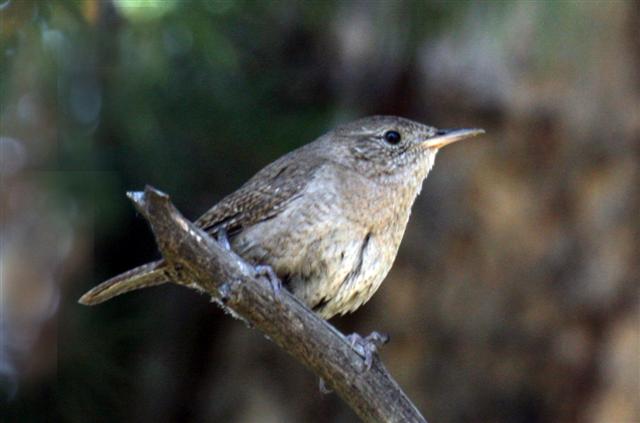
House wren (Troglodytes aedon). I heard this tiny little bird singing in my yard today. It has a beautiful song. You can listen to a sample of the song of the house wren here, but mine was singing better than this. I need to get some decent equipment so I can record audio in the field.
Posted by Rob Kiser on July 16, 2008 at 1:53 PM : Comments (0) | Permalink
July 13, 2008
Rufous Hummingbird
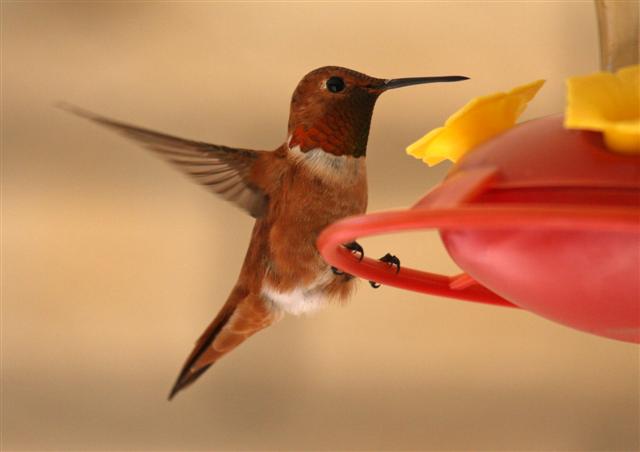
Rufous Hummingbird (Selasphorus rufus).
Posted by Rob Kiser on July 13, 2008 at 11:32 PM : Comments (0) | Permalink
July 11, 2008
American Crow
American Crow (Corvus brachyrhynchos).
Posted by Rob Kiser on July 11, 2008 at 10:34 PM : Comments (0) | Permalink
July 5, 2008
House Wren
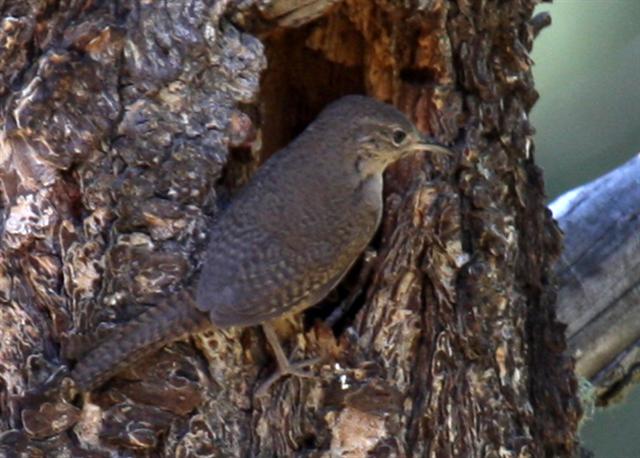
House wren (Troglodytes aedon).
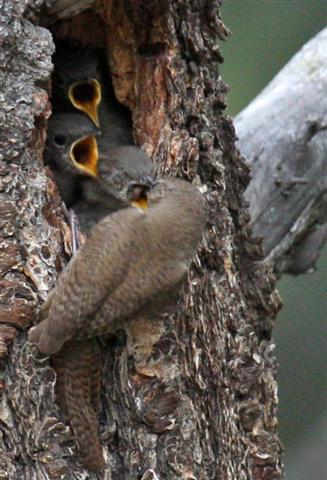
House wrens (Troglodytes aedon) are cavity nesting birds. These wrens live in a hole in my neighbor's dead tree. Here one of the parents feeds the babies. They appear to be ready to fledge in the next day or so.
Posted by Rob Kiser on July 5, 2008 at 10:27 PM : Comments (0) | Permalink
July 1, 2008
Red Crossbills
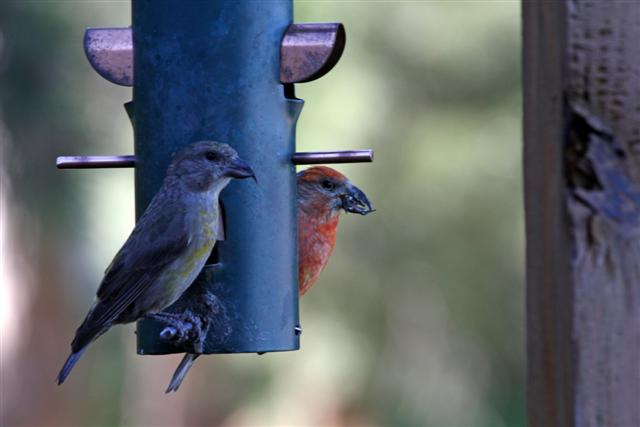
Male and Female Red Crossbills (Loxia curvirostra).
Posted by Rob Kiser on July 1, 2008 at 10:11 AM : Comments (0) | Permalink
Mallard
Mallard drake (Anas platyrhynchos).
Posted by Rob Kiser on July 1, 2008 at 9:56 AM : Comments (0) | Permalink
June 30, 2008
Red-winged Blackbirds
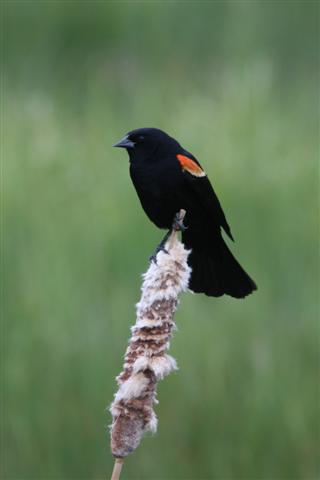
Male Red-winged Blackbird (Agelaius phoeniceus).
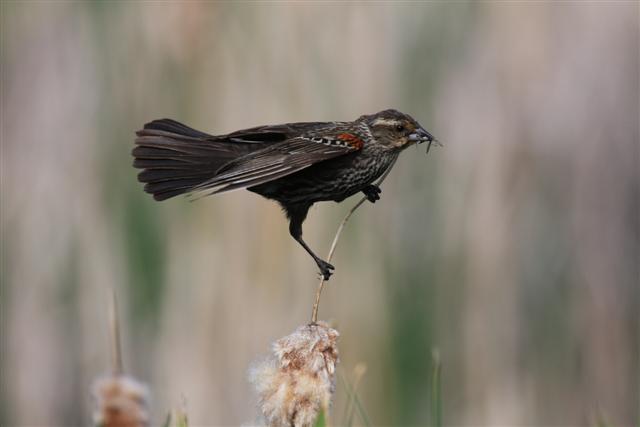
Female Red-winged Blackbird (Agelaius phoeniceus).
Posted by Rob Kiser on June 30, 2008 at 10:55 PM : Comments (0) | Permalink
June 29, 2008
American Dipper
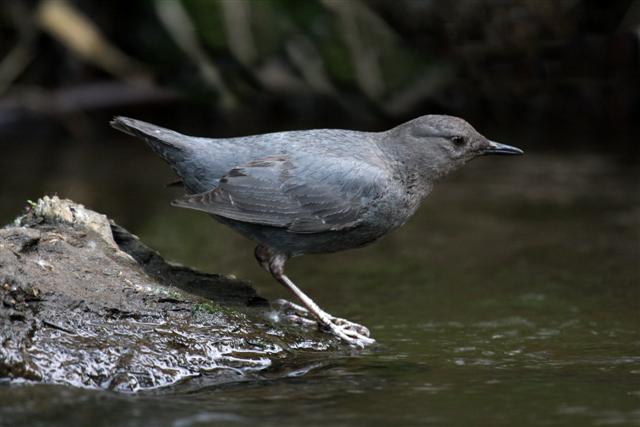
American Dipper (Cinclus mexicanus).
Posted by Rob Kiser on June 29, 2008 at 8:51 PM : Comments (1) | Permalink
Dark-eyed Junco
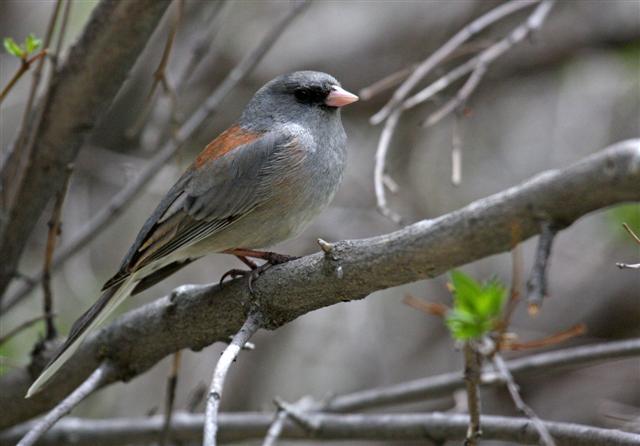
Gray-headed Dark-eyed Junco (Junco hyemalis).
Posted by Rob Kiser on June 29, 2008 at 1:40 PM : Comments (0) | Permalink
June 28, 2008
Great Horned Owl (Immature)
Fledgling Great Horned Owl (Bubo virginianus) near Morrison, Colorado.
Posted by Rob Kiser on June 28, 2008 at 9:49 PM : Comments (0) | Permalink
Common House Finch (Male)
Common House Finch (Carpodacus mexicanus)
Posted by Rob Kiser on June 28, 2008 at 11:59 AM : Comments (0) | Permalink
White-breasted Nuthatch
White-breasted Nuthatch (Sitta carolinensis).
Posted by Rob Kiser on June 28, 2008 at 11:57 AM : Comments (0) | Permalink
Broad-tailed Hummingbird (Female )
Broad-tailed Hummingbird (Selasphorus platycercus).
Posted by Rob Kiser on June 28, 2008 at 11:53 AM : Comments (0) | Permalink
American Crow
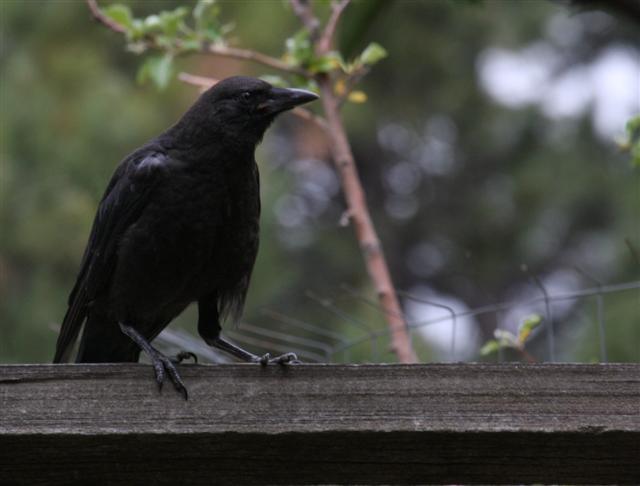
American Crow (Corvus brachyrhynchos).
Posted by Rob Kiser on June 28, 2008 at 11:11 AM : Comments (0) | Permalink
June 27, 2008
Northern Red-Shafted Flicker
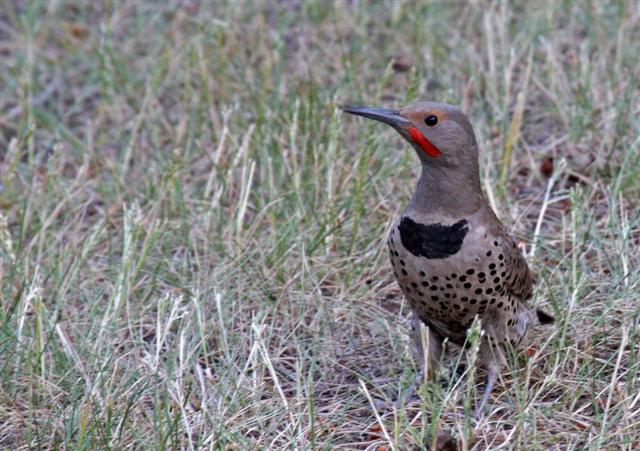
The Northern Red-Shafted Flicker(Colaptes auratus cafer) is a common bird up here in the hills. They're notorious for drilling into the neighbor's house. This one is digging in the dirt in front of my house for reasons not entirely clear.
Posted by Rob Kiser on June 27, 2008 at 10:52 AM : Comments (0) | Permalink
June 20, 2008
Western Bluebird (Male)
Male Western Bluebird (Sialia mexicana).
Posted by Rob Kiser on June 20, 2008 at 10:12 PM : Comments (0) | Permalink
Mountain Bluebird (Male)
Mountain Bluebird (Sialia currucoides).
I shot this photo this evening of the daddy bluebird feeding the babies. They're such good parents. I'll be sad when the babies leave.
Posted by Rob Kiser on June 20, 2008 at 8:27 PM : Comments (0) | Permalink